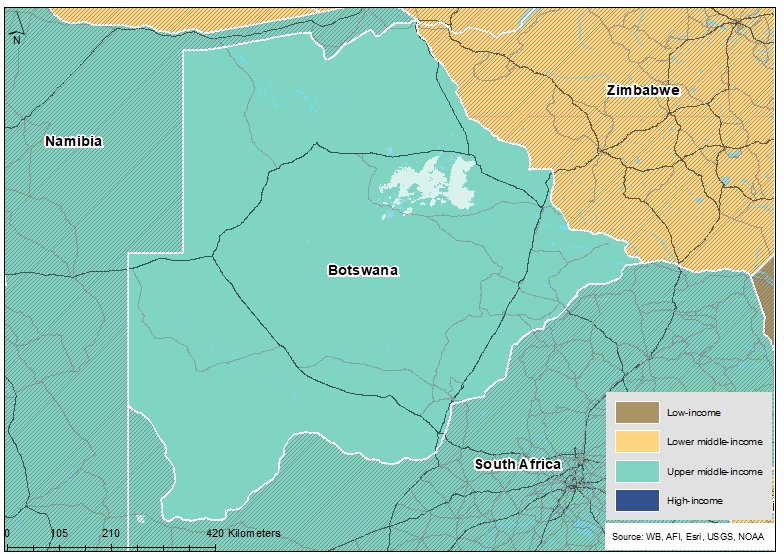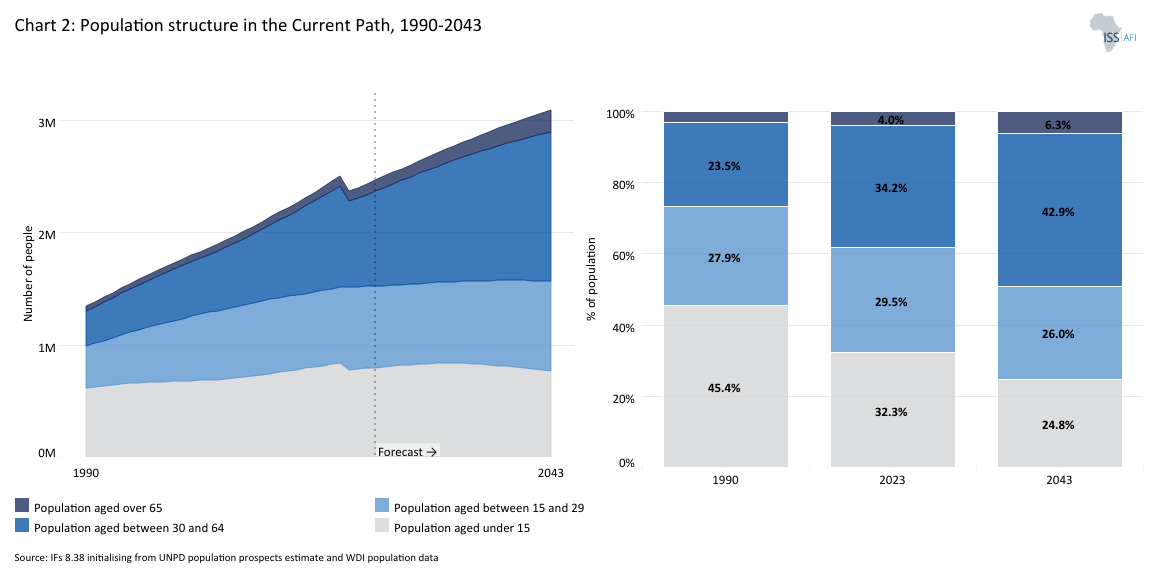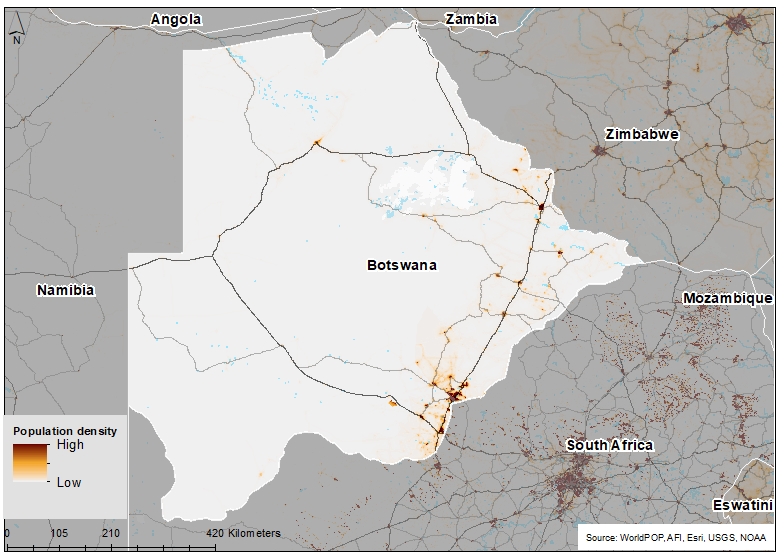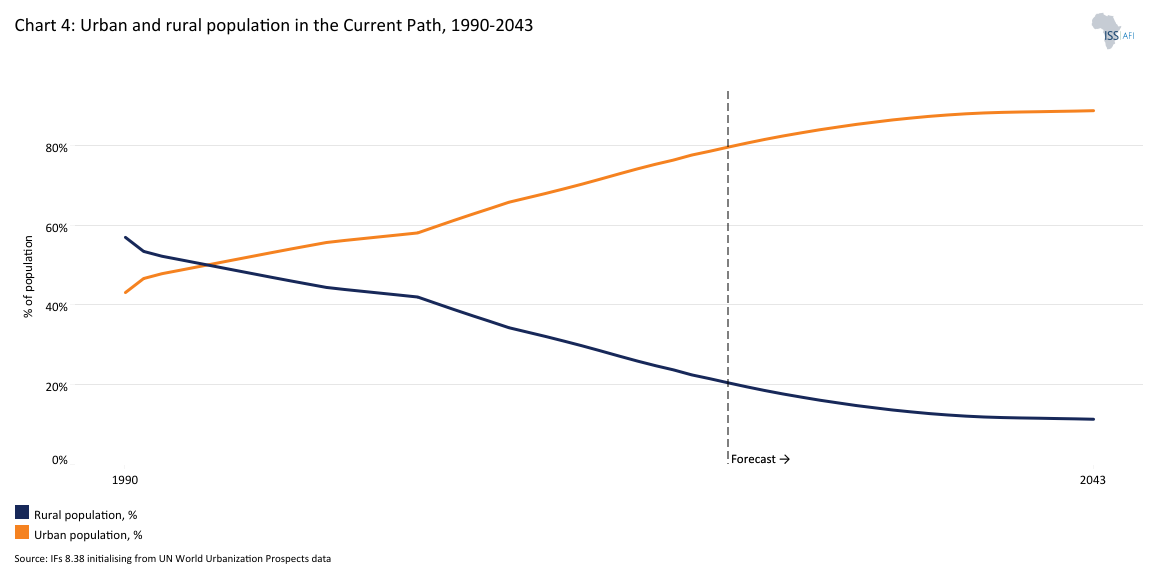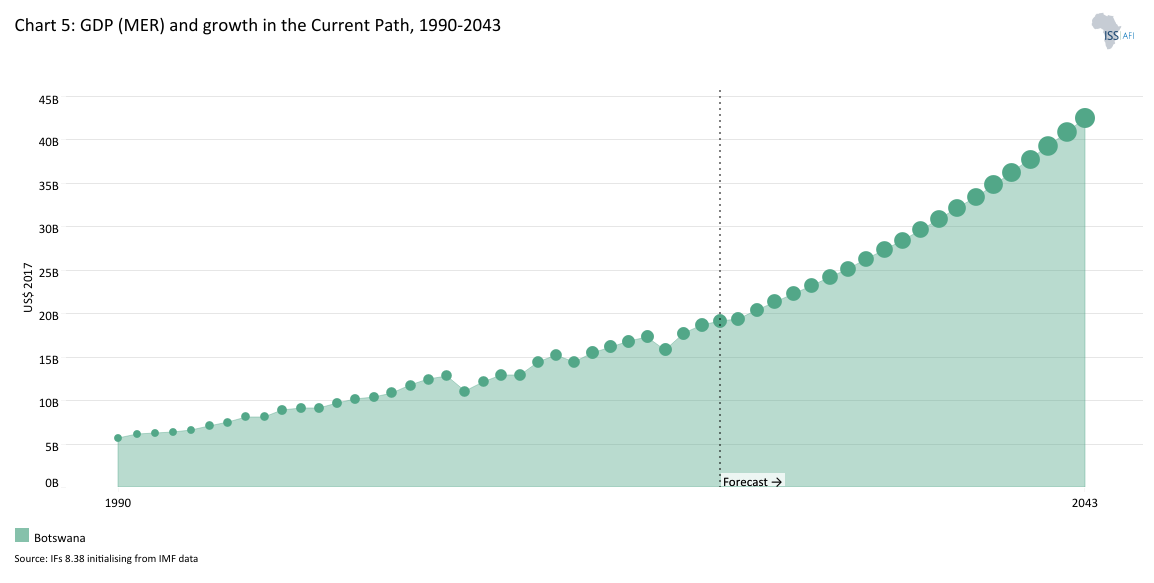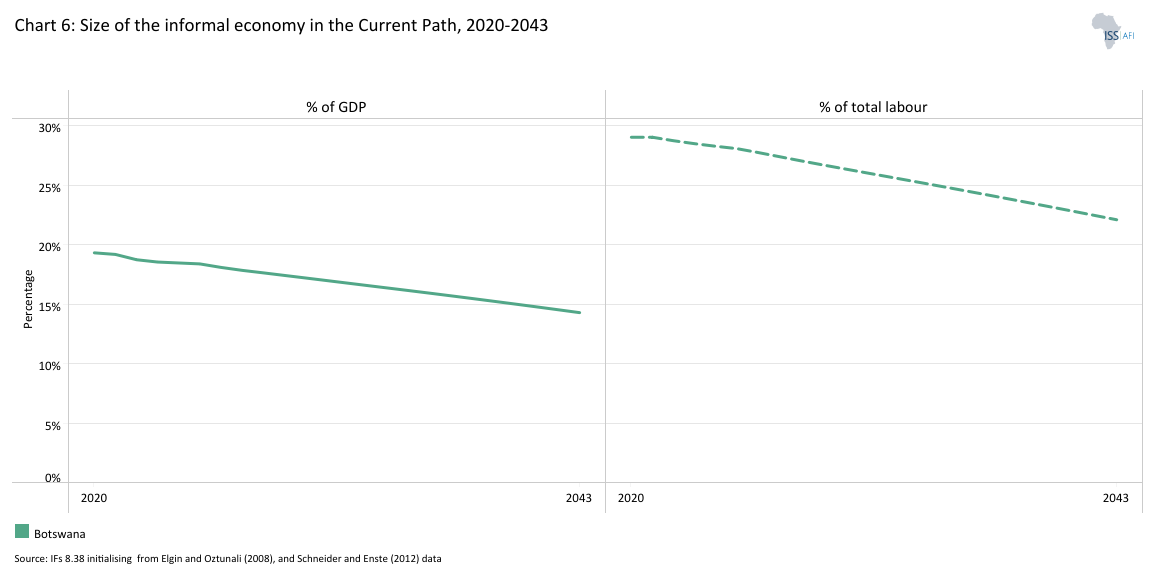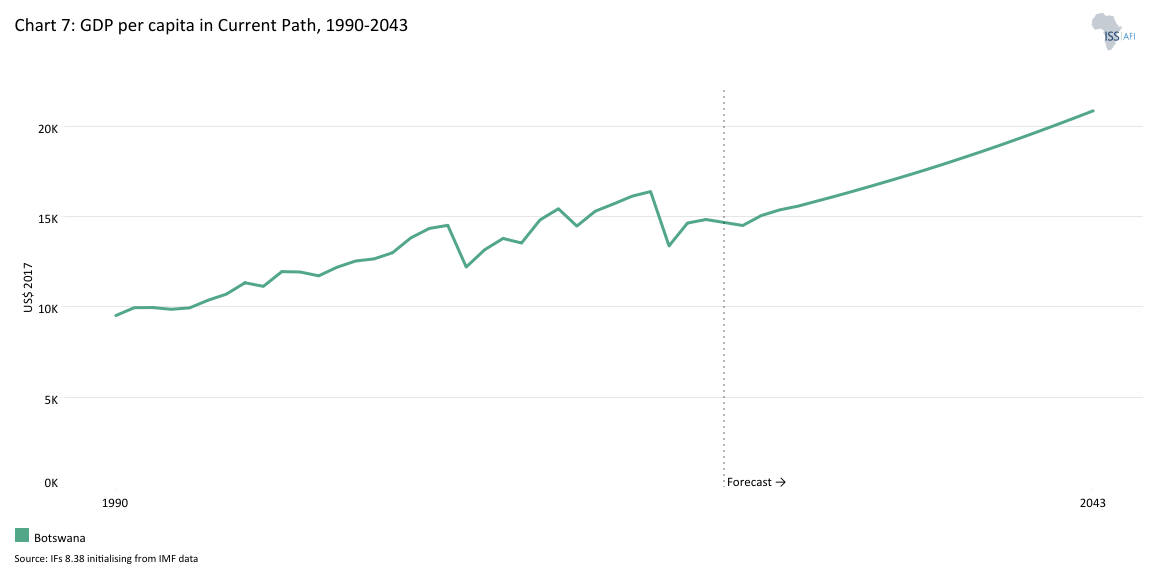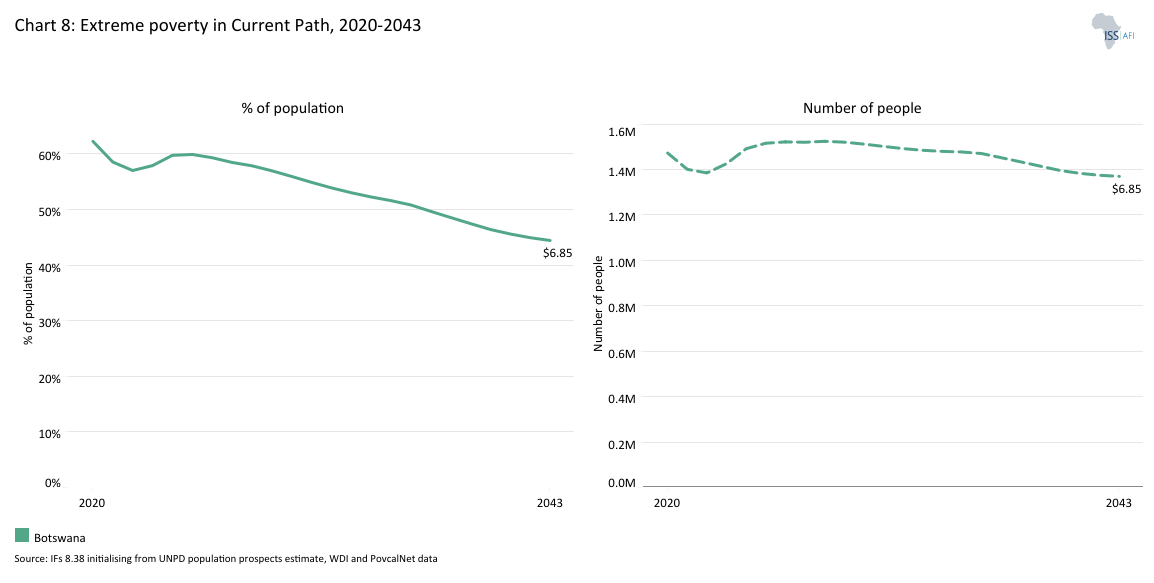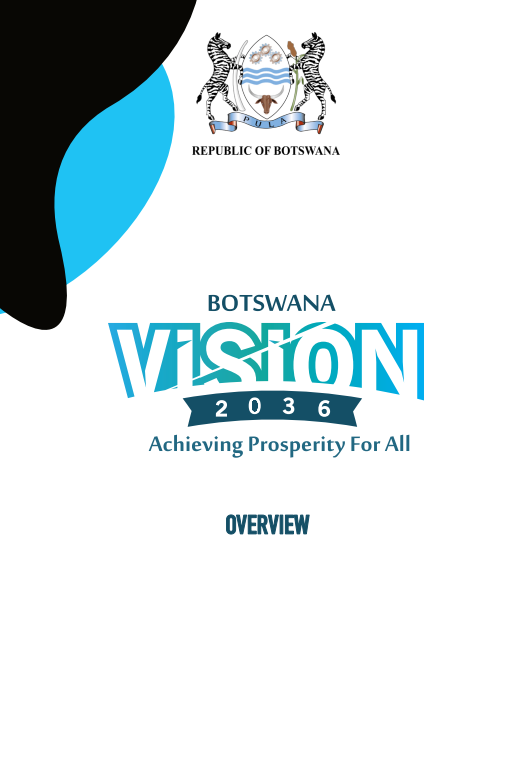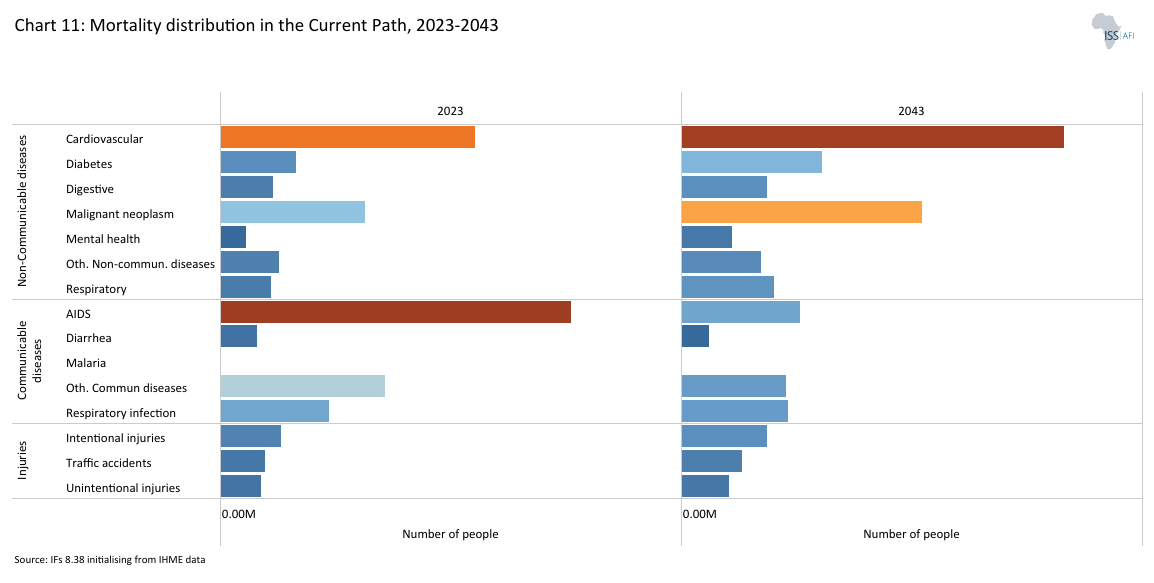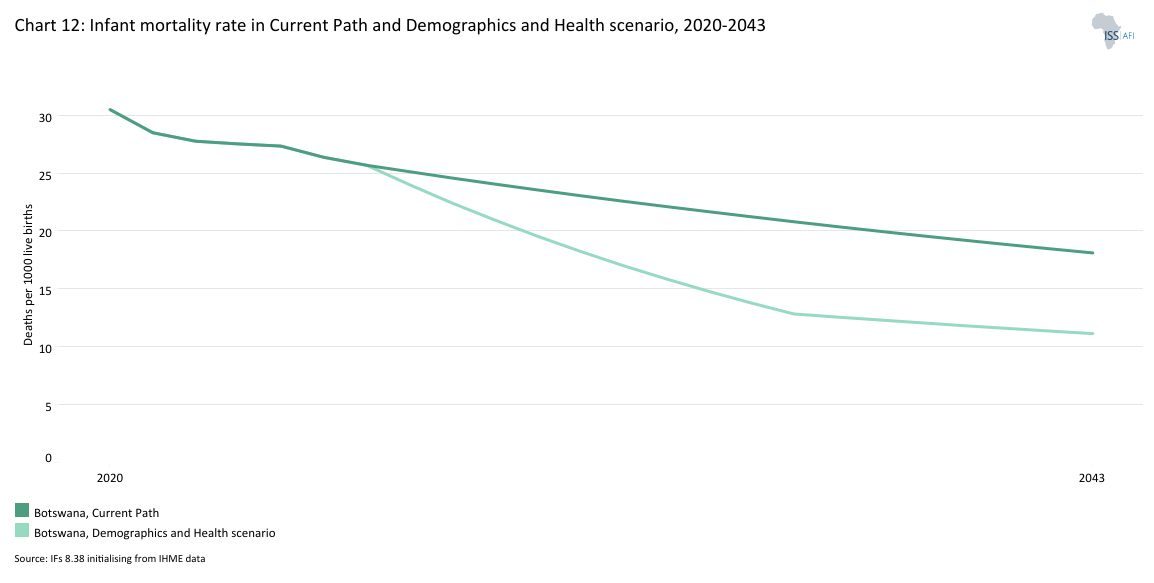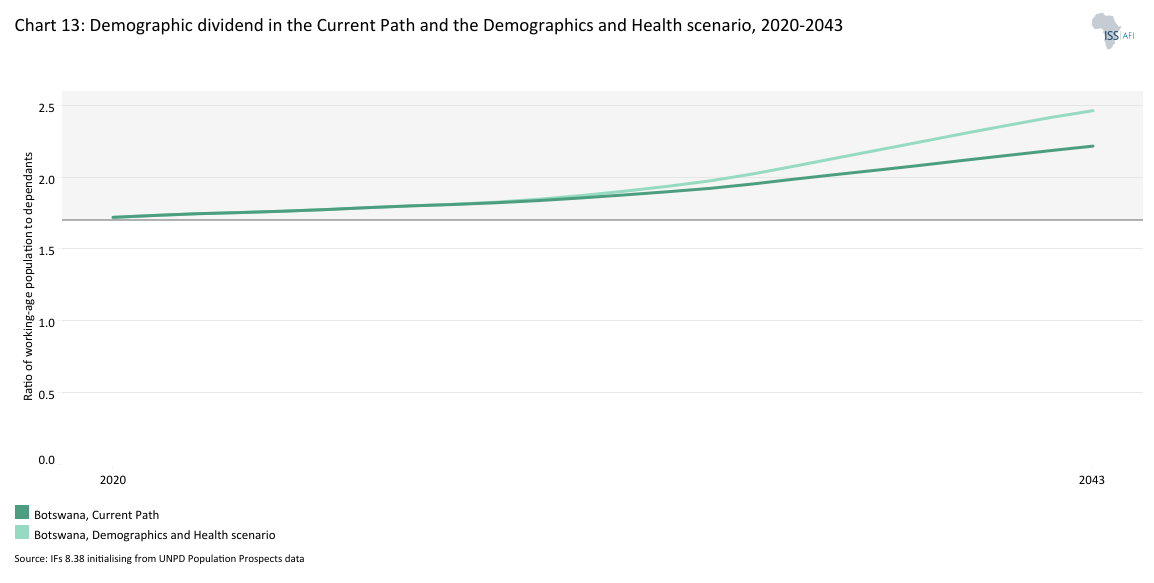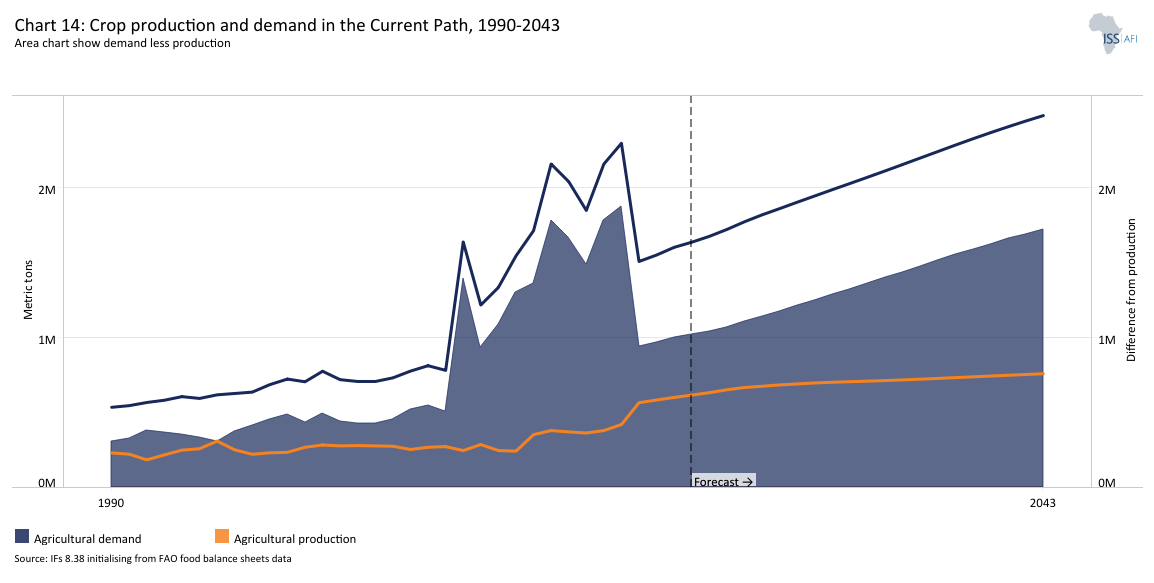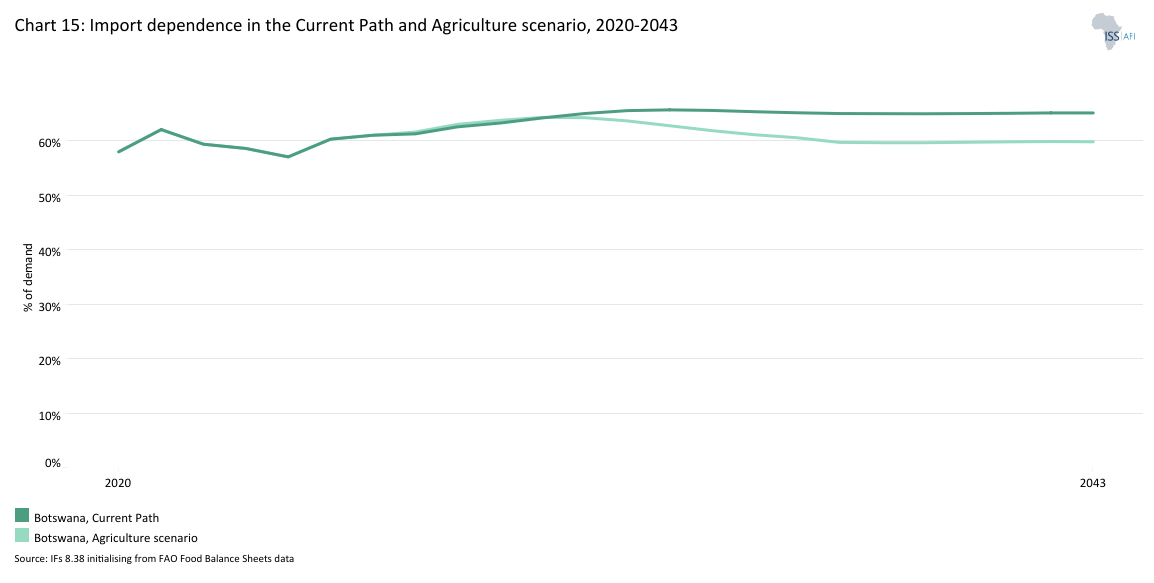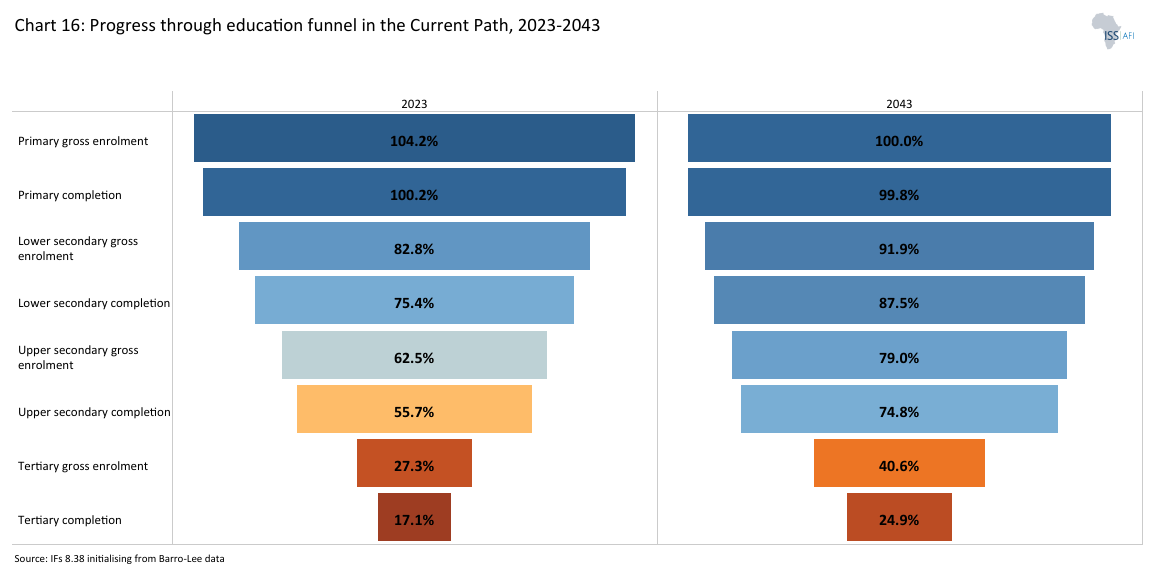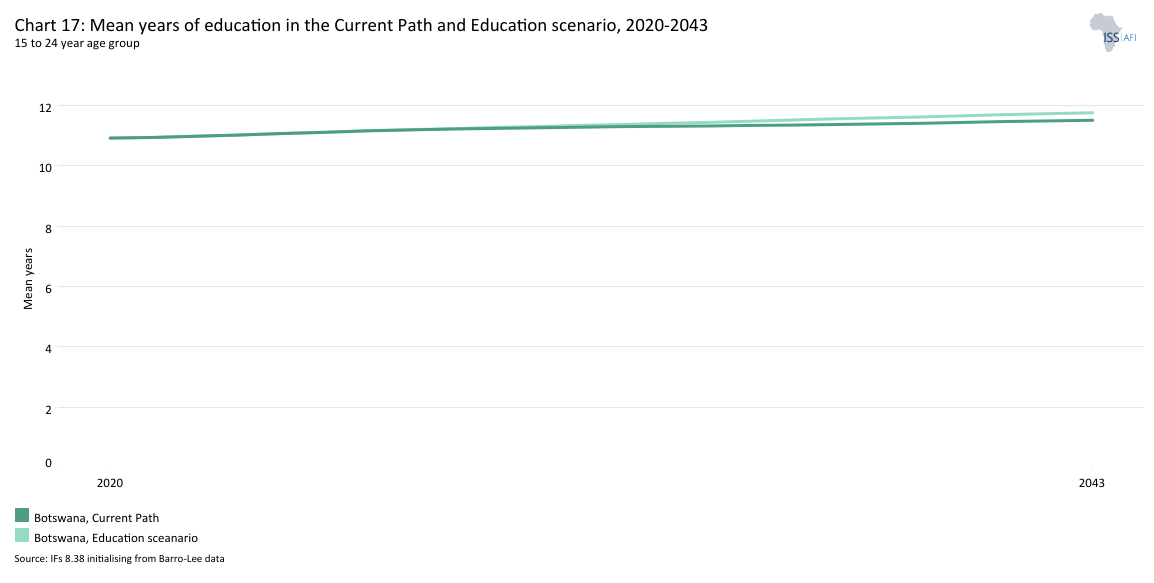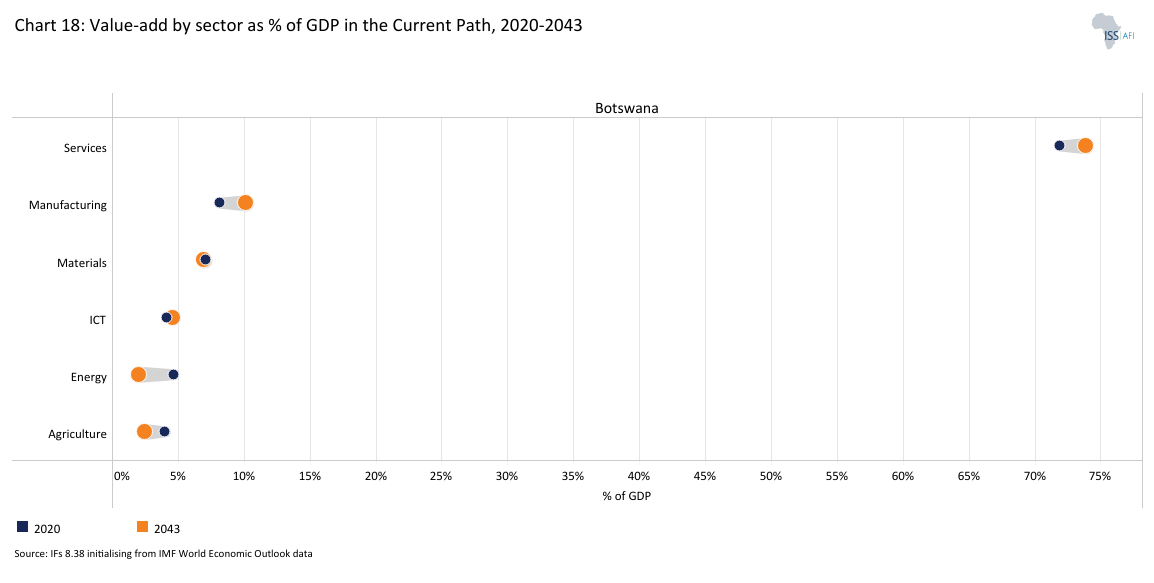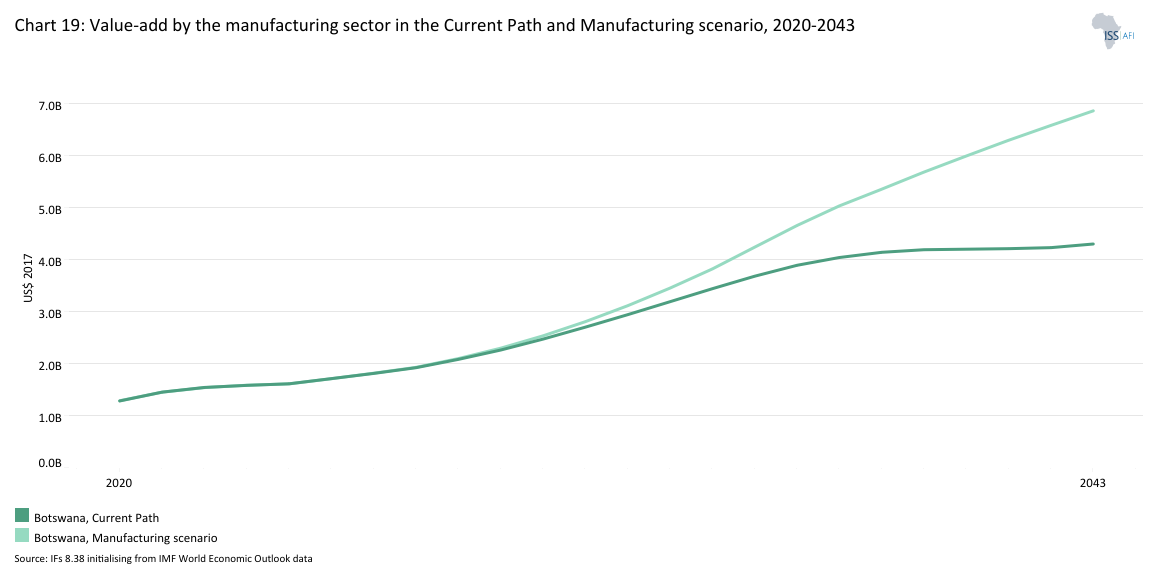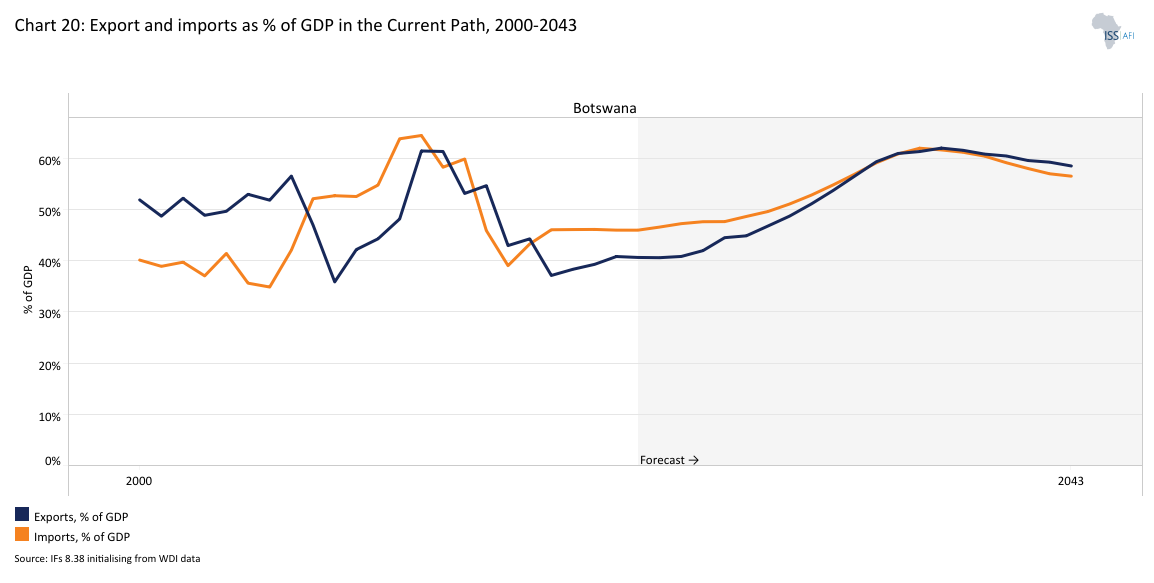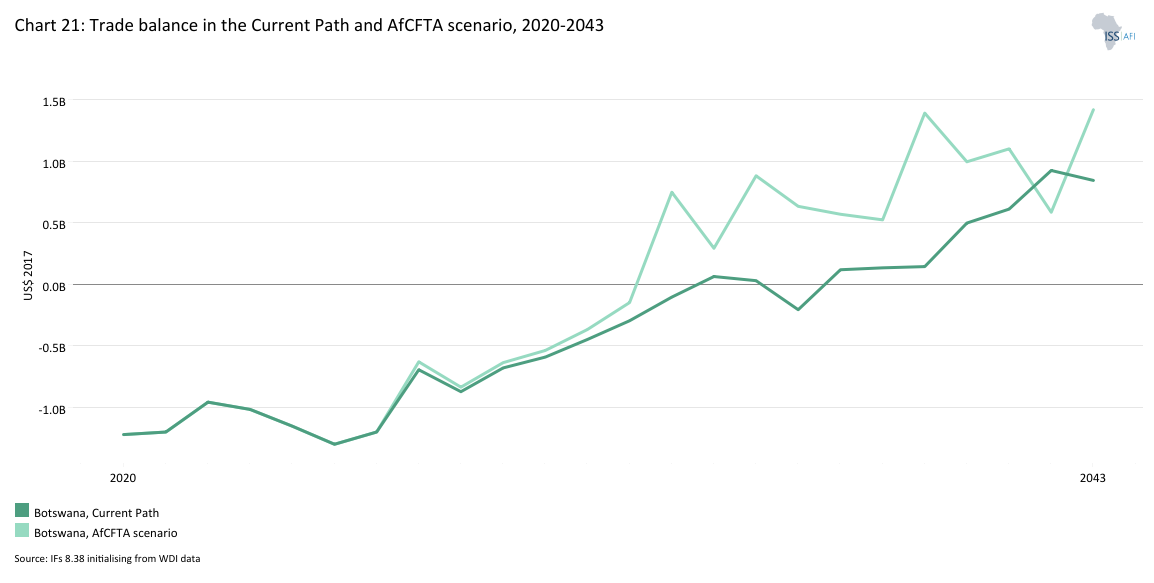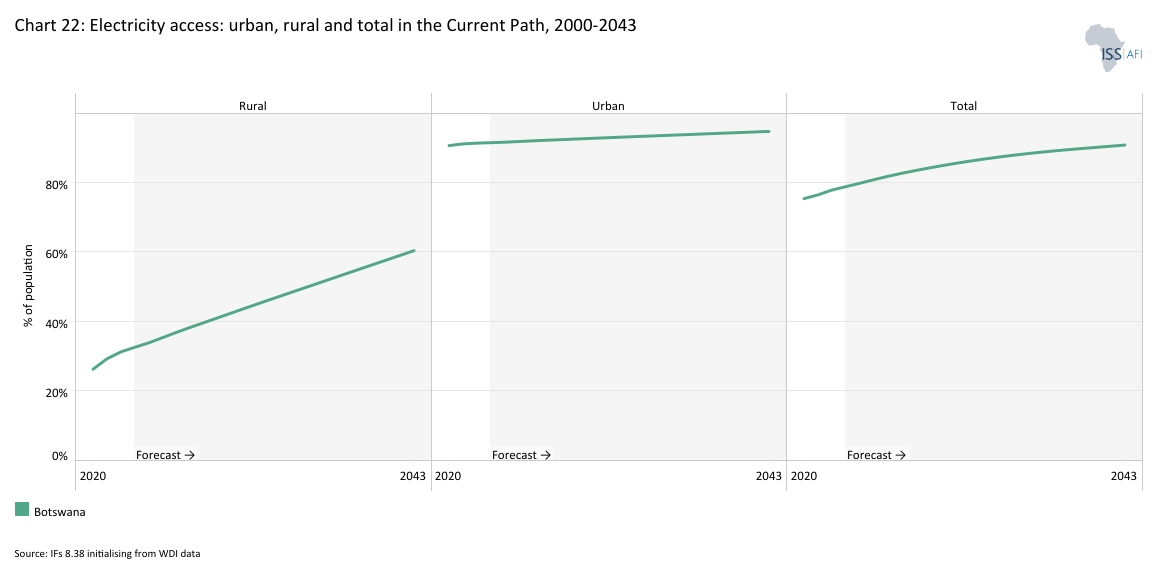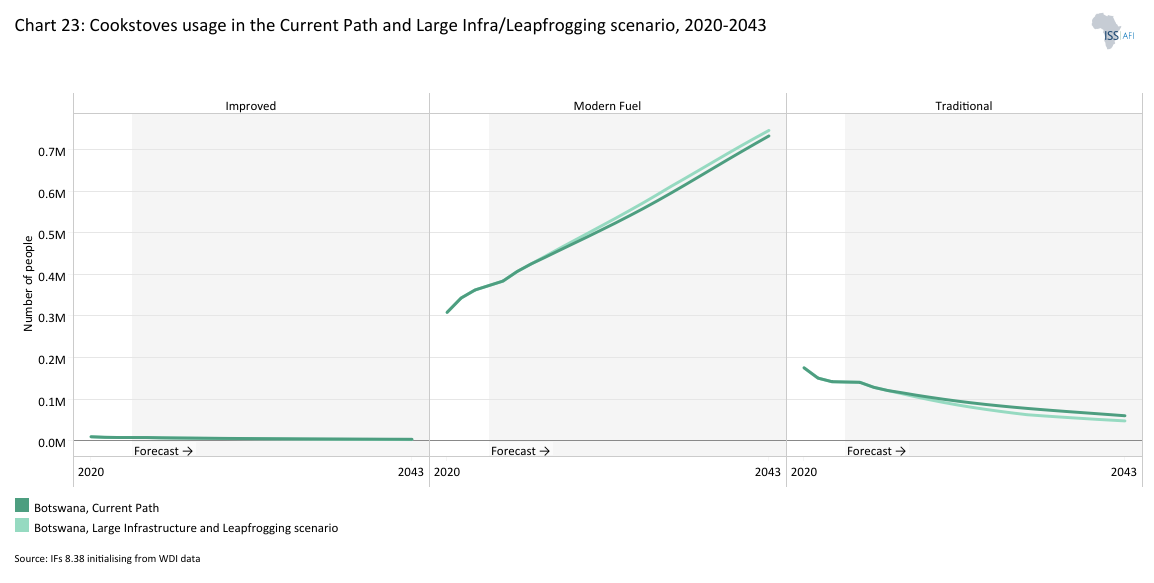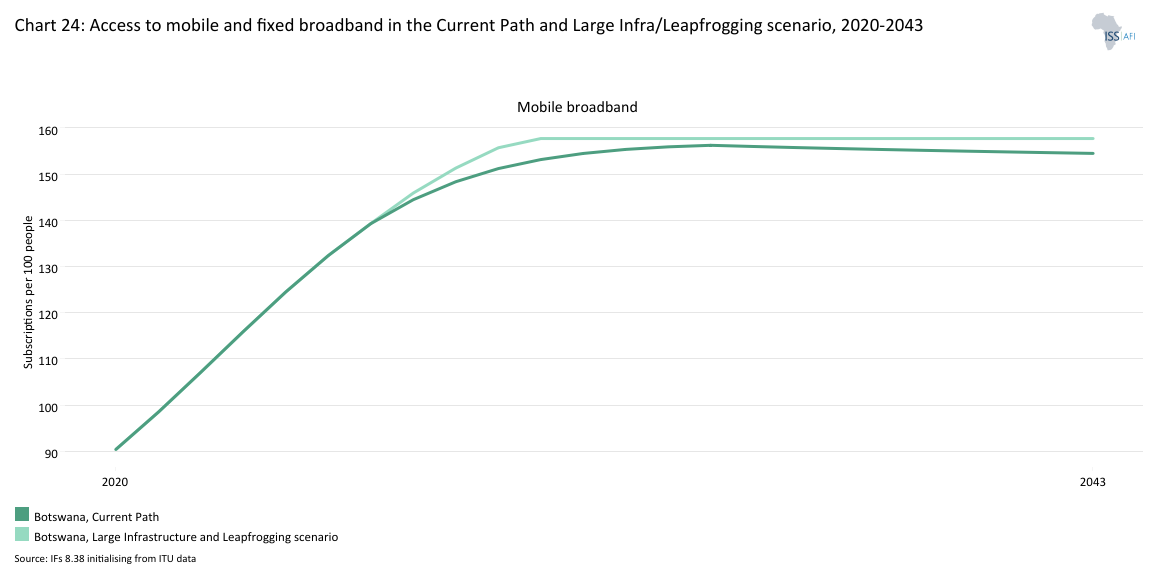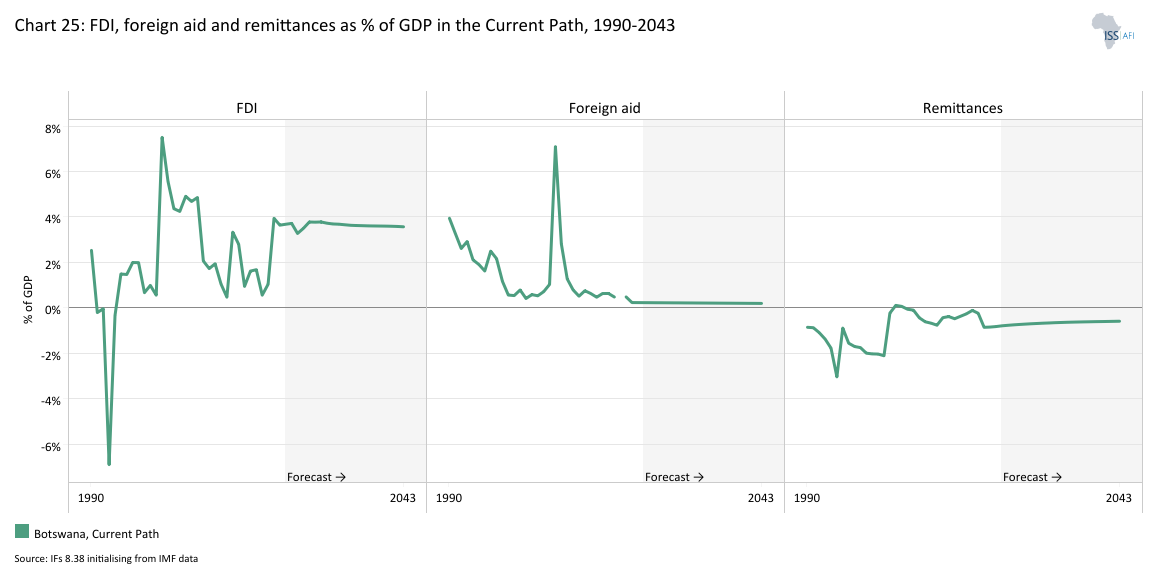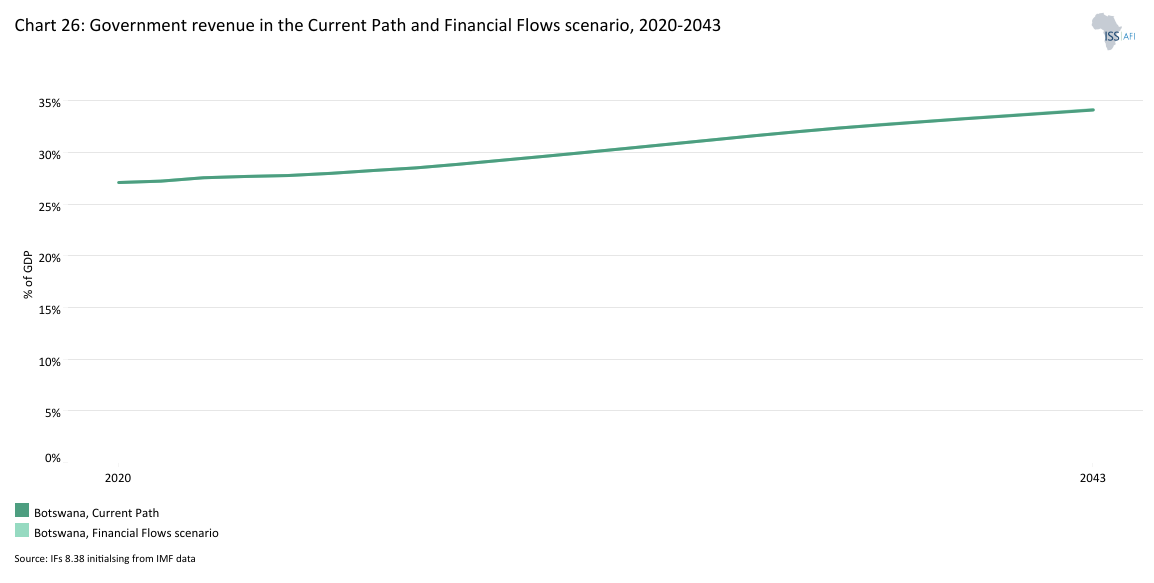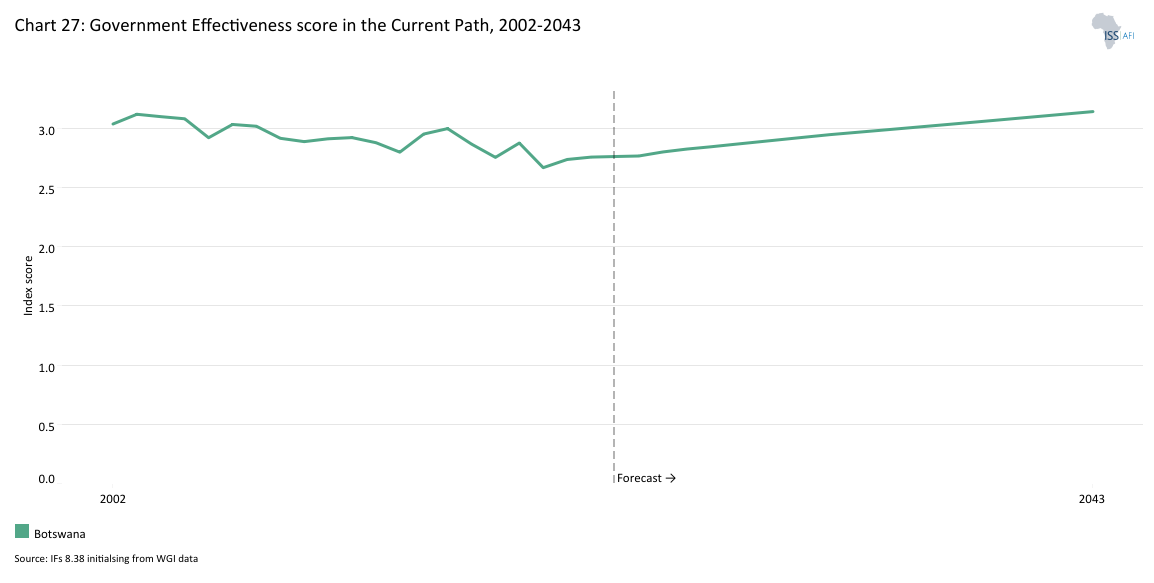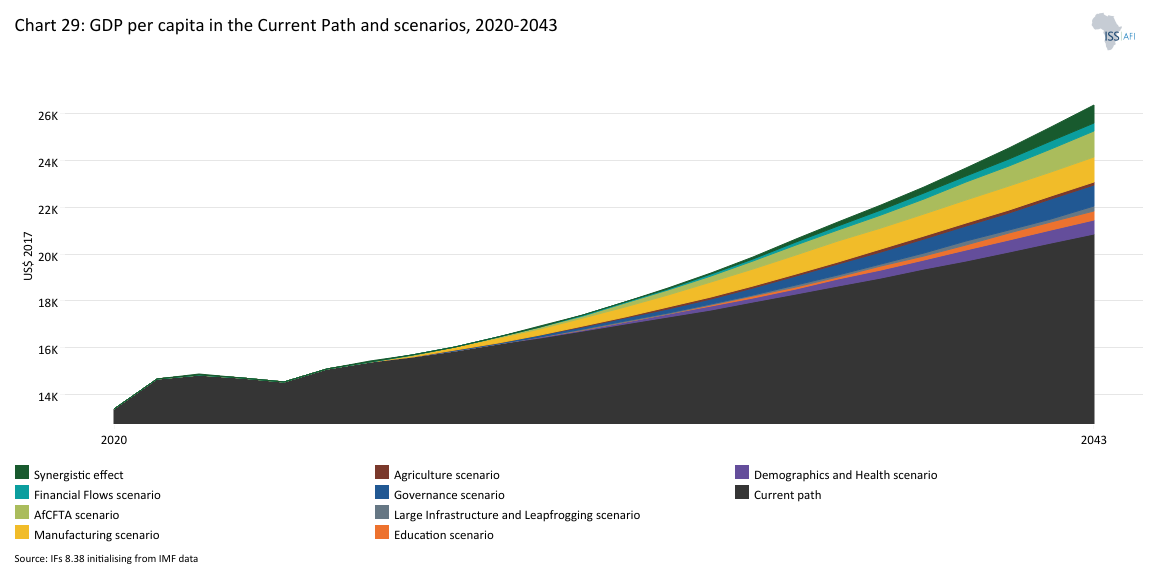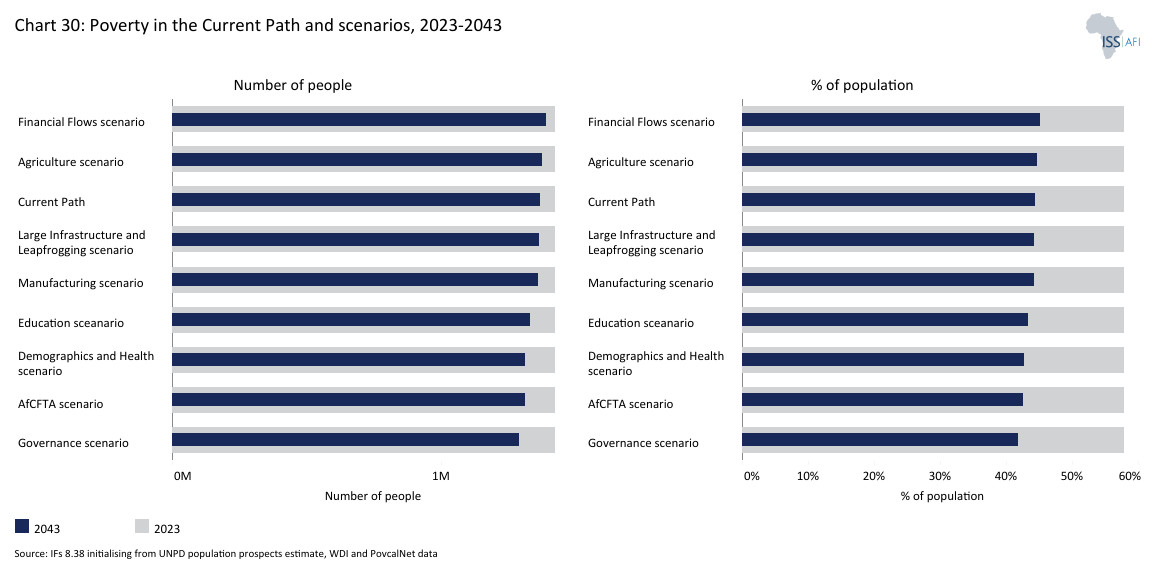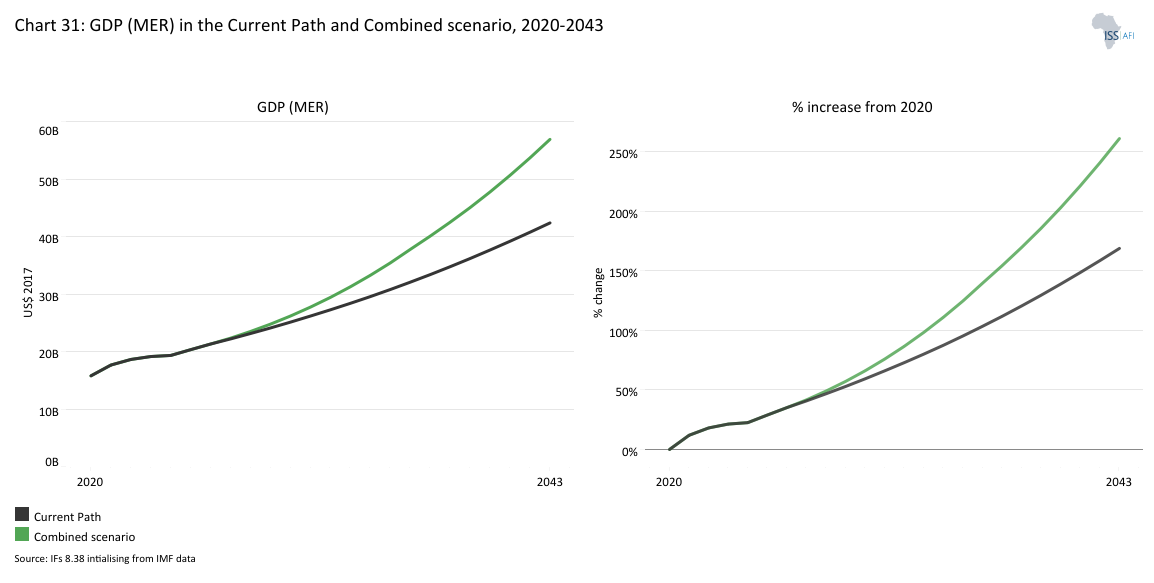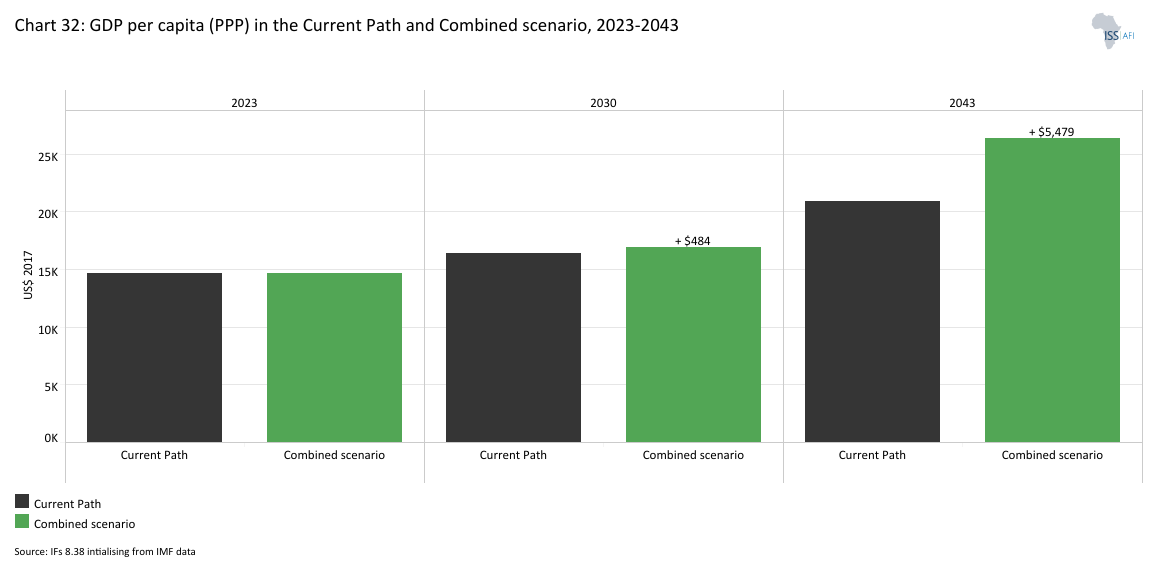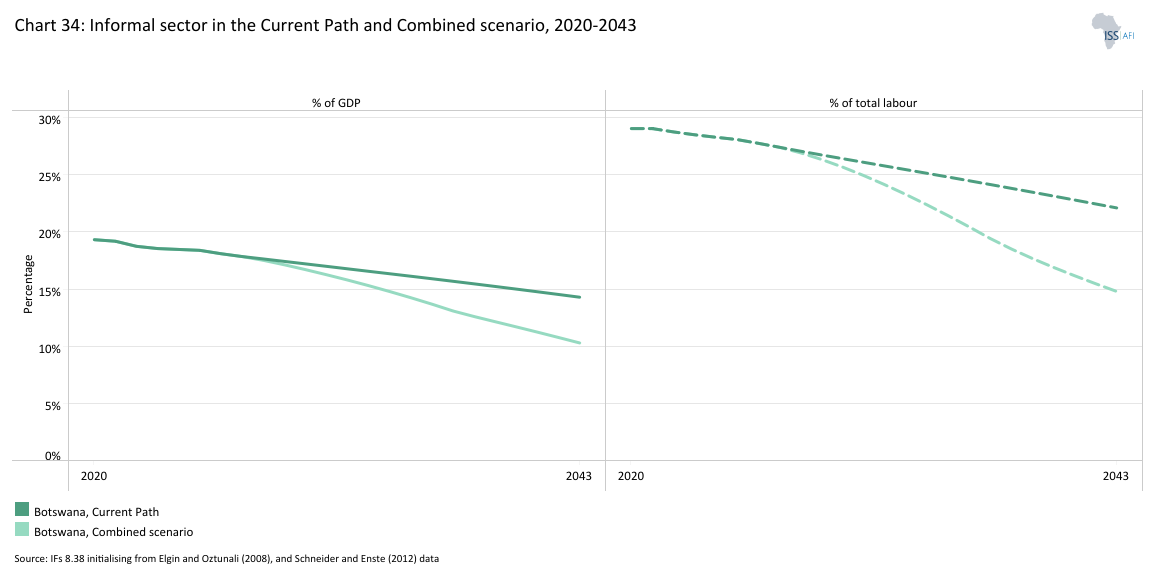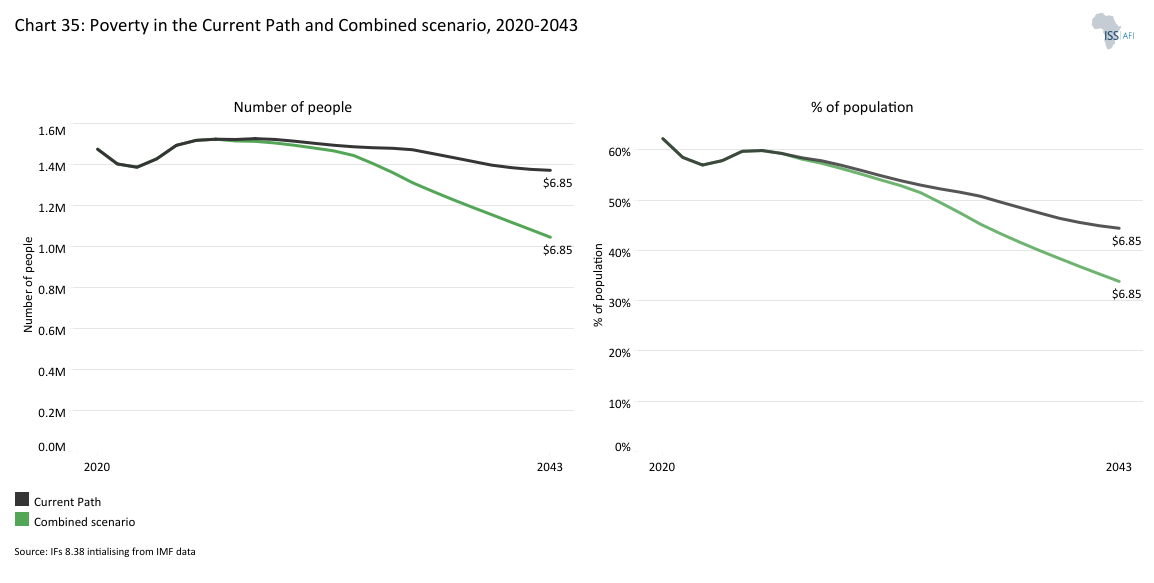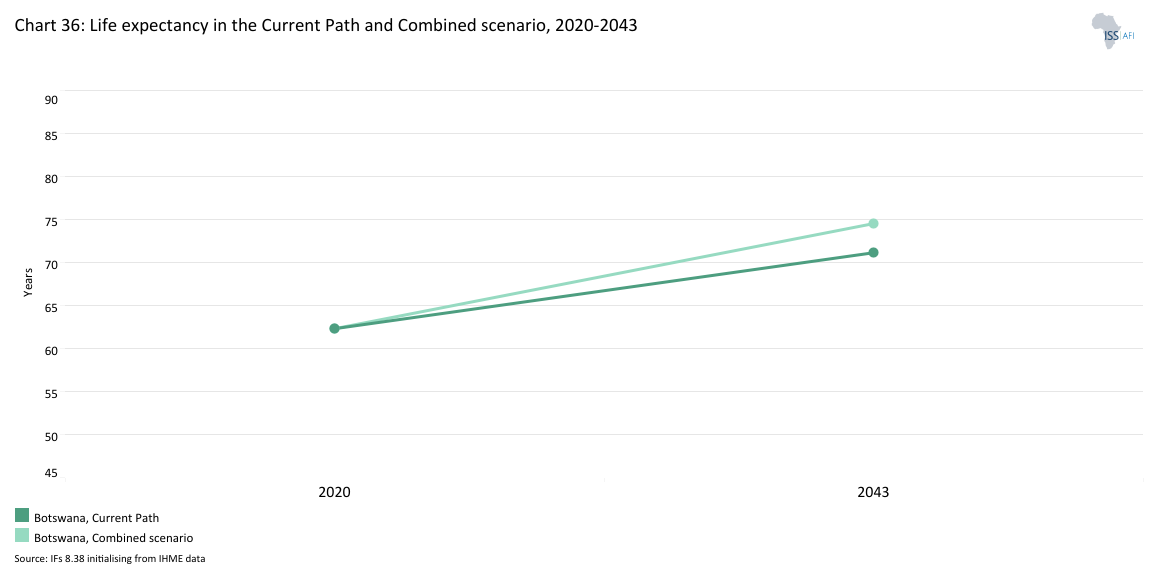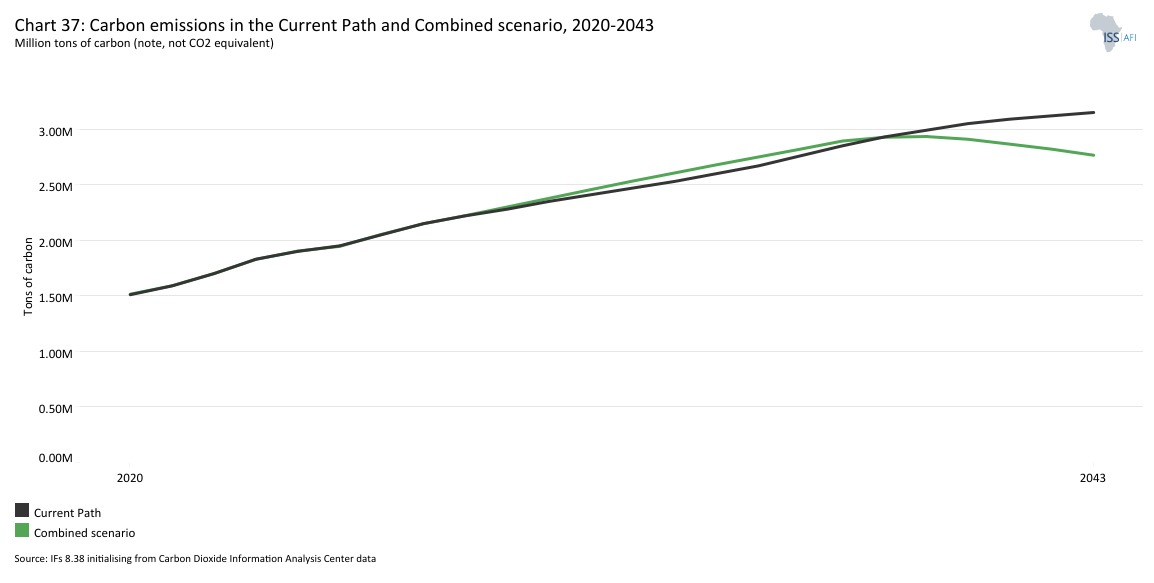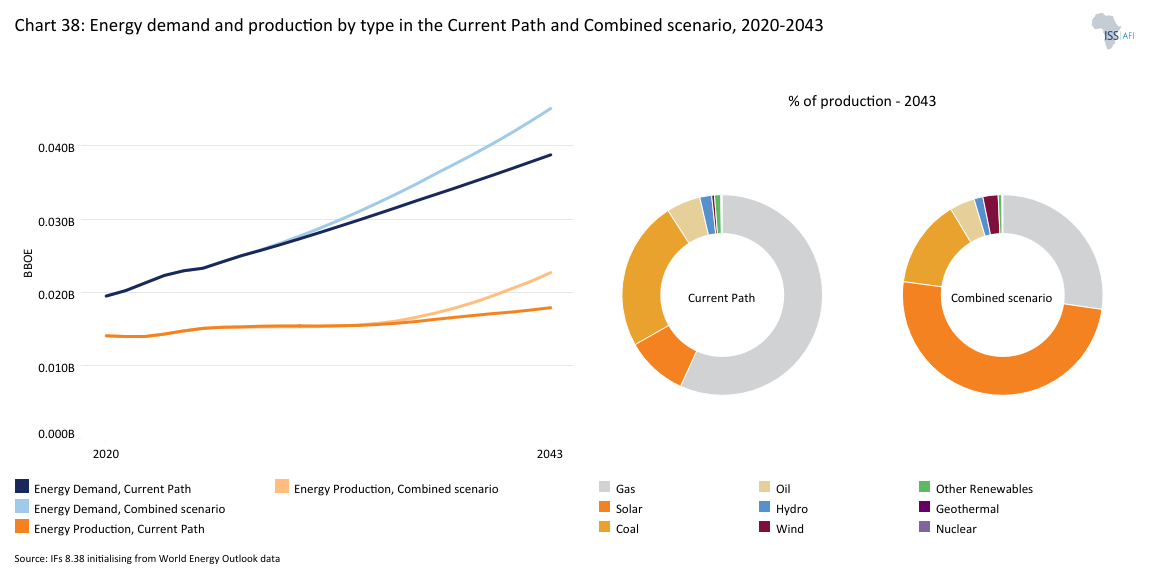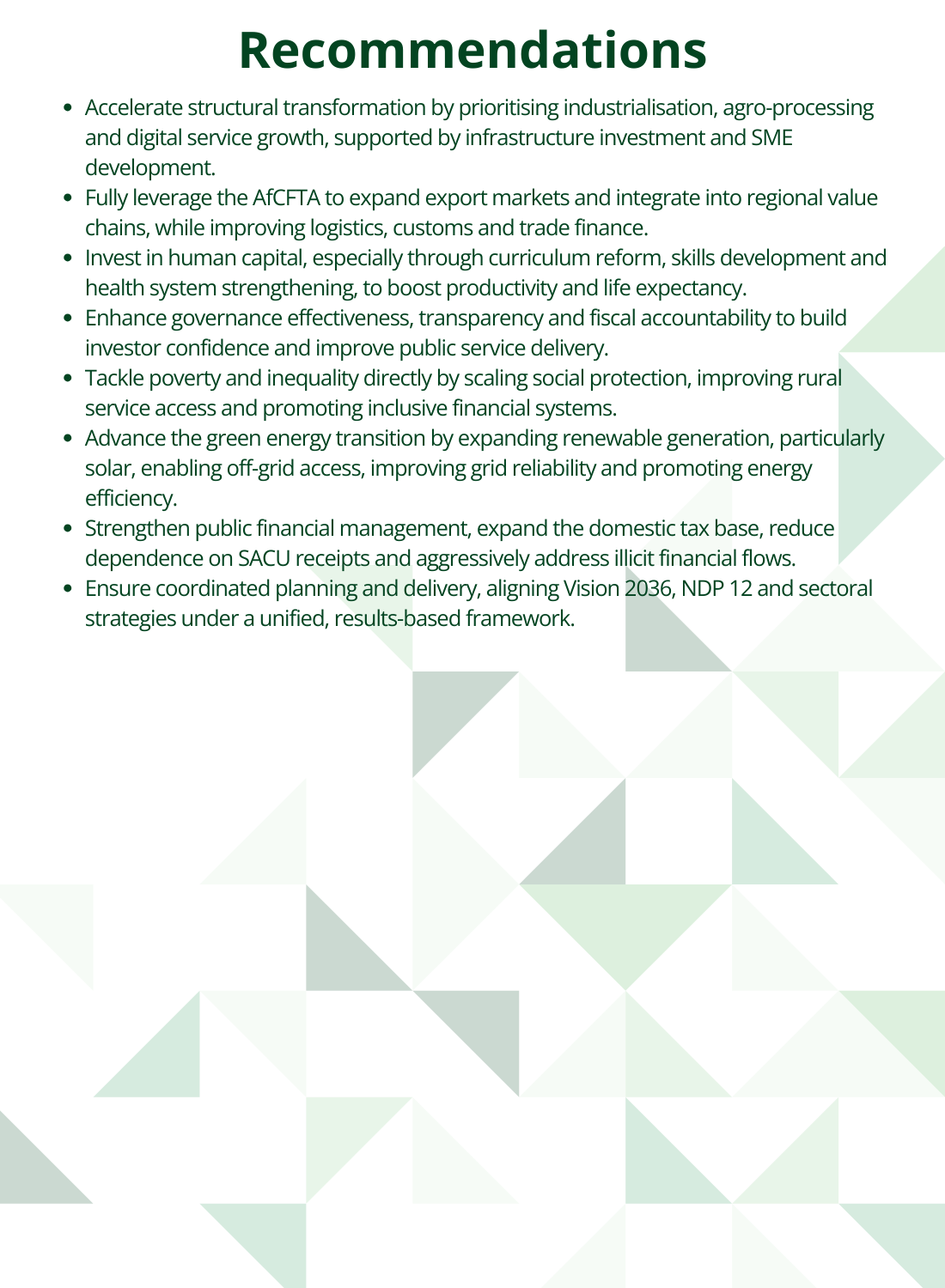 Botswana
Botswana
Feedback welcome
Our aim is to use the best data to inform our analysis. See our Technical page for information on the IFs forecasting platform. We appreciate your help and references for improvements via our feedback form.
This report analyses Botswana’s current development path and prospects, examining how various sectoral interventions could shape the country’s economic and social landscape through to 2043, the end of the third ten-year implementation plan of the African Union's Agenda 2063. The analysis is grounded in scenario modelling and explores eight key sectors: Demographics and Health, Agriculture, Education, Manufacturing, Large Infrastructure and Leapfrogging, the African Continental Free Trade Area (AfCFTA), Financial Flows, and Governance. In addition to evaluating the effects of each sectoral scenario individually, the report assesses the combined impact of these interventions on Botswana’s long-term growth and development trajectory. The report concludes by summarising the key findings and offering policy insights to support Botswana in pursuing a more inclusive, resilient, and sustainable development path. It underscores the importance of coordinated, multi-sectoral reforms to unlock the country’s long-term economic and social potential.
Visit the Technical section for additional information on the International Futures (IFs) modelling platform, which serves as the analytical foundation for this report's scenario simulations.
Summary
This page begins with an introductory assessment of the country’s context, examining current population distribution, social structure, climate and topography.
- Botswana is a semi-arid, landlocked country in Southern Africa that is bordered by Namibia, Zimbabwe, Zambia and South Africa. It has transitioned from one of the world’s poorest countries at independence in 1966 to a stable multiparty democracy with upper-middle-income status. It now faces a strategic imperative to deepen structural transformation and achieve inclusive, high-income growth by 2036 under its national development blueprint, Vision 2036.
The introduction is followed by an analysis of the Current Path for Botswana, which informs the country’s likely current development trajectory to 2043. It is based on current geopolitical trends and assumes that no major shocks would occur in a ‘business-as-usual’ future.
- Botswana’s population will grow from 2.46 million in 2023 to 3.08 million by 2043, with a steadily improving working-age ratio that supports a demographic dividend but requires complementary investments in health, education and job creation.
- Botswana’s urban population share almost doubled from about 43% in 1990 to approximately 80% in 2023, and will reach nearly 89% by 2043 under the Current Path. This trend underscores the importance of inclusive urban planning and infrastructure investment in managing rapid urban growth.
- In the Current Path, Botswana’s gross domestic product (GDP) at market exchange rates (MER) will grow from US$19.14 billion in 2023 to US$42.39 billion by 2043, reflecting a moderate average annual growth rate of 4.1% driven primarily by services and consumption.
- Botswana’s GDP per capita in purchasing power parity (PPP) will increase from US$14 670 in 2023 to US$20 850 in 2043 under the Current Path. This indicates gradual improvements in living standards but falling short of the standard for high-income status, if compared with countries like Seychelles.
- The informal sector’s share of GDP will remain above 14% and informal employment above 22% by 2043, signalling persistent labour market informality and limited economic structural transformation.
- Under the Current Path, poverty will decline from 57.9% in 2023 to 44.4% in 2043, reflecting modest progress in income distribution and service access but insufficient to meet national poverty reduction goals.
- Vision 2036 and successive National Development Plans (NDPs) guide Botswana's development trajectory. These strategies outline inclusive growth, human capital development and economic diversification. Yet, high dependence on the diamond sector and persistent implementation gaps, especially in tackling labour market informality, income inequality and poverty, remain key obstacles to reaching high-income status within the Vision 2036 timeframe.
The next section compares progress on the Current Path with eight sectoral scenarios. These are Demographics and Health; Agriculture; Education; Manufacturing; the African Continental Free Trade Area (AfCFTA); Large Infrastructure and Leapfrogging; Financial Flows; and Governance. Each scenario is benchmarked to present an ambitious but reasonable aspiration in that sector, comparing Botswana with other countries at similar levels of development and characteristics.
- The Demographics and Health scenario places Botswana on track to meet the African Union’s Agenda 2063 life expectancy target of 75 years and achieve Sustainable Development Goal 3.2 on neonatal mortality before 2043. Life expectancy reaches 73.7 years, and infant mortality falls to 11 per 1 000 live births by 2043, reflecting sustained investment in maternal health, adolescent services, non-communicable diseases (NCD) prevention and universal healthcare access.
- The Agriculture scenario moderates Botswana’s crop import dependence to 65% of total demand by 2043, down from almost 72% forecast under the Current Path, reflecting gains in domestic production and food system resilience. However, to translate this into significant poverty reduction, there is a need to better integrate smallholder farmers, scale agro-processing and strengthen climate resilience, particularly in rural areas.
- Under the Education scenario, average schooling among youth aged 14-24 years increases to 11.8 years by 2043, with narrowing gender gaps and improved learning outcomes. These gains enhance human capital and productivity, while contributing to moderate poverty reduction, reinforcing the role of education reform and digital inclusion in long-term growth.
- The Manufacturing scenario drives a revitalised industrial base, with manufacturing value-added exceeding 15% of GDP by 2043, catalysing job creation and income growth, especially in the medium term. It affirms industrial policy, infrastructure and small to medium enterprise (SME) support as critical to Botswana’s structural transformation.
- Under the AfCFTA scenario, Botswana’s share of trade balance in GDP shifts from a 5.3% deficit in 2023 to a 3.1% surplus by 2043, as AfCFTA implementation boosts exports and market access. The scenario delivers the highest gains in per capita income by 2043 and accelerates export diversification, confirming regional integration as a key lever for long-term competitiveness.
- The Large Infrastructure and Leapfrogging scenario accelerates the transition to clean cooking, with almost 94% of households using modern fuel cookstoves by 2043, significantly reducing emissions and expanding renewable energy production. It also boosts growth in digital services, though rural access gaps remain and require targeted infrastructure and affordability measures.
- In the Financial Flows scenario, foreign direct investment (FDI) inflows rise to 5.2% of GDP by 2043, peaking at 6% in 2036, enabling Botswana to meet its medium-term sustainable financing strategy target. While this drives growth, the impact on poverty and inequality is limited, highlighting the need for policies that align capital inflows with inclusive employment and local enterprise development.
- Improved government effectiveness, accountability and public service delivery under the Governance scenario yield the largest reductions in poverty and boost fiscal efficiency. It reinforces governance reform as a foundational enabler of inclusive, sustainable development across all sectors.
The fourth section compares the impact of each of these eight sectoral scenarios with one another and subsequently with a Combined scenario (the integrated effect of all eight scenarios). The forecasts measure progress on various dimensions such as economic size (in market exchange rates), gross domestic product (GDP) per capita (in purchasing power parity), extreme poverty, carbon emissions, the changes in the structure of the economy, and selected sectoral dimensions such as progress with mean years of education, life expectancy, the Gini coefficient or reductions in mortality rates.
- In the Combined Scenario, Botswana’s GDP (MER) reaches US$56.93 billion by 2043, compared to US$42.39 billion under the Current Path, driven by broad-based productivity gains, structural transformation and improved institutional effectiveness. The average annual growth rate rises to 5.6% from 2024 to 2043, compared to 4.1% on the baseline, reflecting the compounding impact of coordinated, cross-sectoral reforms.
- GDP per capita increases to US$26 330 by 2043, nearly US$5 500 higher than in the Current Path, indicating more inclusive and sustained improvements in living standards. These gains reflect stronger labour market performance, export competitiveness and human capital development.
- Poverty (at less US$6.85/day) declines to 34.7% by 2043 under the Combined scenario, nearly 10 percentage points below the Current Path, due to faster income growth, expanded service delivery and more equitable distribution of development outcomes. Progress is further reinforced by improvements in governance, education and rural infrastructure development.
- The Combined scenario drives a more balanced economic structure, with manufacturing’s share of GDP rising to over 13% by 2043, 3 percentage points above the baseline. Gains in ICT (+0.37 percentage points) and agriculture (+0.22) complement this shift, while all sectors expand in absolute terms, signalling broad-based growth and deeper diversification.
- Informality declines significantly, with the informal sector’s GDP share falling to 10.3% and informal employment dropping to 14.8% by 2043, compared to over 14% and 22% in the Current Path. These changes reflect labour market formalisation, skills development and SME integration into formal value chains.
- Despite faster economic growth, total carbon emissions under the Combined scenario are 400 000 tons lower than in the Current Path by 2043, reaching 2.8 million tons. Emission reductions stem from accelerated adoption of clean energy, energy efficiency and sustainable infrastructure planning.
- Domestic energy production rises from 14 million barrels of oil equivalent (BOE) in 2023 to 23 million BOE by 2043 under the Combined scenario, 5 million BOE higher than the Current Path forecast, driven primarily by a surge in solar and wind generation. However, energy demand outpaces supply, growing to over 45 million BOE, resulting in a continued but manageable energy deficit that underscores the need for regional integration and efficiency measures.
The analysis concludes with a summarising section offering recommendations. Botswana has made significant socio-economic progress since independence, but its current development trajectory under the Current Path is not sufficient to achieve the country’s Vision 2036 goal of high-income, inclusive growth. The Combined scenario demonstrates that coordinated investments across governance, human capital, infrastructure, trade and energy can yield transformative results, raising GDP per capita, reducing poverty and accelerating structural change. It also shows that inclusive development is compatible with environmental sustainability, with lower carbon emissions and increased renewable energy generation. To realise this potential, Botswana must prioritise industrial policy, educational reform, digital infrastructure and climate-smart agriculture, while deepening regional integration through AfCFTA. Strengthening public financial management, reducing informality and expanding social protection are equally critical to ensure broad-based and equitable growth. With strategic implementation, Botswana can shift from incremental progress to a dynamic, diversified and inclusive development path.
All charts for Botswana
- Chart 1: Political map of Botswana
- Chart 2: Population structure in the Current Path, 1990–2043
- Chart 3: Population distribution map, 2023
- Chart 4: Urban and rural population in the Current Path, 1990-2043
- Chart 5: GDP (MER) and growth rate in the Current Path, 1990–2043
- Chart 6: Size of the informal economy in the Current Path, 2020-2043
- Chart 7: GDP per capita in Current Path, 1990–2043
- Chart 8: Extreme poverty in the Current Path, 2020–2043
- Chart 9: National Development Plan of Botswana
- Chart 10: Relationship between Current Path and Scenarios
- Chart 11: Mortality distribution in the Current Path, 2023 and 2043
- Chart 12: Infant mortality rate in Current Path and Demographics and Health scenario, 2020–2043
- Chart 13: Demographic dividend in the Current Path and the Demographics and Health scenario, 2020–2043
- Chart 14: Crop production and demand in the Current Path, 1990-2043
- Chart 15: Import dependence in the Current Path and Agriculture scenario, 2020–2043
- Chart 16: Progress through the education funnel in the Current Path, 2023 and 2043
- Chart 17: Mean years of education in the Current Path and Education scenario, 2020–2043
- Chart 18: Value-add by sector as % of GDP in the Current Path, 2023 and 2043
- Chart 19: Value-add by the manufacturing sector in the Current Path and Manufacturing scenario, 2020–2043
- Chart 20: Exports and imports as % of GDP in the Current Path, 2000-2043
- Chart 21: Trade balance in the Current Path and AfCFTA scenario, 2020–2043
- Chart 22: Electricity access: urban, rural and total in the Current Path, 2000-2043
- Chart 23: Cookstove usage in the Current Path and Large Infra/Leapfrogging scenario, 2020–2043
- Chart 24: Access to mobile and fixed broadband in the Current Path and the Large Infra/Leapfrogging scenario, 2020–2043
- Chart 25: FDI, foreign aid and remittances as % of GDP in the Current Path and in the Financial Flows scenario, 1990-2043
- Chart 26: Government revenue in the Current Path and Financial Flows scenario, 2020–2043
- Chart 27: Government effectiveness score in the Current Path, 2002-2043
- Chart 28: Composite governance index in the Current Path and Governance scenario, 2023 and 2043
- Chart 29: GDP per capita in the Current Path and scenarios, 2020–2043
- Chart 30: Poverty in the Current Path and Scenarios, 2020–2043
- Chart 31: GDP (MER) in the Current Path and Combined scenario, 2020–2043
- Chart 32: GDP per capita in the Current Path and the Combined scenario, 2020-2043
- Chart 33: Value added by sector in the Current Path and Combined scenario, 2023 and 2043
- Chart 34: Informal sector in the Current Path and Combined scenario, 2020–2043
- Chart 35: Poverty in the Current Path and Combined scenario, 2023 and 2043
- Chart 36: Life expectancy in the Current Path and Combined scenario, 2020–2043
- Chart 37: Carbon emissions in the Current Path and Combined scenario, 2020–2043
- Chart 38: Energy demand and production by type in the Current Path and Combined scenario, 2020-2043
- Chart 39: Policy recommendations
Chart 1 is a political map of Botswana.
Botswana is a landlocked country in Southern Africa, bordered by Namibia to the west and north, Zimbabwe to the northeast, South Africa to the south and southeast, and a narrow crossing to Zambia at the Kazungula Bridge in the north. It covers about 566 730 km², slightly bigger than France (547 557 km²), and has a relatively flat terrain dominated by the Kalahari Desert in the central and southern regions.
In the north, the famed Okavango Delta and Makgadikgadi salt pans provide unique wetlands amid the arid landscape. The climate is semi-arid, with erratic summer rainfall varying from approximately 576 mm in the northeast to under 280 mm in the southwest. Recurrent droughts pose challenges like desertification and water scarcity, forcing reliance on groundwater. Despite the dry climate, Botswana sustains rich wildlife in well-protected parks, making it a popular eco-tourism destination.
Politically, Botswana is a stable multiparty parliamentary republic that achieved independence from British colonial rule on 30 September 1966, transitioning from the Bechuanaland Protectorate to the Republic of Botswana. Since gaining independence, Botswana has developed into one of Africa’s most stable democratic institutions, which helped transform it from one of the poorest countries at independence into an upper-middle-income economy. Led initially by Seretse Khama, the country established strong democratic institutions and achieved steady economic growth. His successors, Quett Masire (1980–1998), Festus Mogae (1998–2008) and Ian Khama (2008–2018), maintained political continuity and pursued economic reforms, though Khama’s tenure drew criticism for undermining press freedom. In 2018, Mokgweetsi Masisi took office, pledging democratic renewal amid internal party rifts. A historic shift occurred in 2024 when the opposition, Umbrella for Democratic Change (UDC), a centre-left to left-wing alliance of political parties in Botswana, led by Duma Boko, won the general election. This ended the Botswana Democratic Party’s 58-year rule and marked a peaceful transfer of power that reaffirmed the country's democratic credentials.
The capital city is Gaborone, and English is the official language. The majority of the population speaks Setswana (Tswana), the national language, along with other indigenous languages such as Kalanga and Sekgalagadi.
Botswana is a member of regional bodies like the Southern African Development Community (SADC) and the Southern African Customs Union (SACU). Its long-standing political stability, sound macroeconomic policies and effective governance have enabled it to avoid the resource curse that has afflicted many other mineral-rich African countries. Despite its heavy reliance on diamond exports, which account for approximately 80% of export earnings and about 25% of GDP, Botswana has maintained prudent fiscal discipline, accumulated substantial foreign reserves and achieved sustained economic growth over the decades.
A cornerstone of Botswana's success is its joint venture with De Beers, known as Debswana, which manages major diamond mines including Jwaneng and Orapa. This partnership has not only generated substantial revenue but also facilitated investments in infrastructure, education and healthcare, contributing to the nation's development.
In 2025, Botswana renegotiated its agreement with De Beers, increasing its share of diamond sales from 25% to 30%, with plans to reach a 50-50 split in the coming years. This move aims to ensure greater national benefit from diamond revenues and reflects the country's proactive approach to resource management.
However, the country faces challenges due to fluctuations in the global diamond market. In 2024, diamond exports declined by 50% compared to the previous year, highlighting the vulnerability associated with heavy reliance on a single commodity. In response, Botswana is actively pursuing economic diversification strategies, focusing on sectors like tourism, agriculture and manufacturing to build a more resilient economy.
Chart 2 presents the Current Path of the population structure from 1990 to 2043.
Botswana’s population has grown steadily, from approximately 1.31 million in 1990 to 2.46 million in 2023. The Current Path suggests that it will reach 3.08 million by 2043. However, this growth has not been uniform across regions or demographic groups. Spatial and socio-economic disparities in population dynamics underscore the need for regionally targeted policies that address uneven development and ensure equitable access to services and opportunities nationwide.
During the late 1990s and early 2000s, the country faced a significant slowdown in population growth, primarily due to the HIV/AIDS epidemic. At its peak, Botswana had one of the highest HIV prevalence rates globally, with nearly 39% of adults living with the virus. This health crisis led to increased AIDS-related mortality rates and a decline in life expectancy, which dropped from about 61 years in 1990 to a historical record low of 45 years in 2002.
Despite these challenges, Botswana has made significant strides in addressing the HIV/AIDS epidemic and improving public health. The country has implemented comprehensive prevention and treatment programs, leading to a reduction in new HIV infections and improvements in life expectancy. These efforts have contributed to the resumption of population growth, albeit at a slower pace compared to earlier decades.
In addition to the impact of HIV/AIDS, Botswana experienced a sharp decline in fertility rates during the 1990-2023 period. The total fertility rate decreased from 4.5 children per woman in 1990 to 2.7 in 2023. This decline was influenced by factors such as increased use of modern contraceptives and integration of family planning services into maternal and child health programs.
The country’s demographic landscape has also undergone significant changes over the past three decades, marked by shifts in age group distributions that underscore the country's ongoing transition from a youthful to a more balanced age structure.
In 1990, approximately 46.5% of the population were children under the age of 15 years. This youthful demographic posed challenges for the country, particularly in providing adequate education and health services to meet the needs of a large dependent population. By 2023, children under 15 had declined to 32.3% of the population, reflecting a demographic transition influenced by factors such as declining fertility rates and improved child survival. In contrast, the share of the working-age population (15-64 years) increased from 52.9% in 1990 to 63.7% by 2023. This implies that Botswana is at an advanced stage of the demographic transition, with a large working-age population and relatively fewer dependents.
The working-age population share will rise to 68.9%, while children under 15 will decline to 24.8% by 2043 under the Current Path. This shift has implications for Botswana's socioeconomic planning, as a decreasing youth population may reduce the strain on educational and healthcare systems, while an increasing working-age population can potentially boost economic productivity. However, to fully capitalise on the potential economic benefits of a larger working-age population, Botswana must invest in education, job creation and skills development to ensure that this segment of the population is effectively integrated into the economy.
The proportion of the elderly (above 65 years) population, though small, will increase by two percentage points from roughly 4% in 2023 to 6.3% by 2043. Life expectancy will also increase from roughly 64 years in 2023 to about 71 years by 2043. This development highlights a growing need for policies and programs that address the health and social care requirements of the elderly population.
Botswana officially entered its demographic dividend phase in 2018, when the ratio of the working-age population (15–64 years) to dependants (children under 15 and adults over 64) reached 1.7. This ratio will improve to 2.2 by 2043 in the Current Path, meaning there will be more than two working-age individuals for every dependant. As the dependency ratio rises above 2.0, countries begin to fully realise the economic gains from demographic change, provided complementary policies are in place. Economically, this shift presents a unique opportunity for accelerated growth: a larger, healthier and better-educated labour force, if gainfully employed, can drive productivity, boost savings and increase per capita income.
However, the dividend is not automatic. For Botswana to convert this demographic window into sustained economic growth, strategic investments are essential, particularly in job creation, quality education and healthcare. This includes aligning the education system with labour market needs, expanding vocational training, and supporting innovation and entrepreneurship to absorb new entrants into the workforce. Without these interventions, the expanding youth population could instead become a source of social and economic strain, manifesting in higher unemployment, underemployment and inequality. The challenge for Botswana lies in seizing this demographic moment through bold reforms in education, economic policy and governance, transforming its youth into a powerful engine of inclusive growth.
Chart 3 presents a population distribution map for 2023.
Botswana is one of Africa’s least populated countries, with a population density of 4 people per km² (equivalent to 0.04 people per hectare) as of 2023. The majority of the population is concentrated in the eastern and south-eastern regions of the country, while the western interior, much of which is the Kalahari Desert and nature reserves, is nearly empty.
The capital, Gaborone and its surrounding areas in the southeast hold a particularly large inhabitant share. More than 10% of the country’s people live in Gaborone alone, and nearly 50% live within 100 km of Gaborone. The second-largest city, Francistown in the far northeast, is another population centre, though much smaller than the capital. Outside these urban nodes and the eastern corridor, settlement is very sparse. Protected areas like national parks in the northwest and central Kalahari have virtually no permanent population.
This uneven distribution means that population density varies widely across Botswana. Densities range from over 1 200 people per km² (equivalent to 12 people per hectare) in Gaborone, which is the most densely populated district, to essentially zero people per km² in the desert interior. Overall, 87% of Batswana live in the eastern hydrological catchment of the Limpopo River, which underscores the eastward concentration. This pattern reflects historical factors such as the colonial-era development of the east, better water availability and transport links like the railway along the east.
Policymakers recognise this imbalance and have, in development plans, noted the need for more spatially balanced development, but the east-west divide in population remains pronounced. The 2022 census reported a total population of 2 359 609, confirming continued moderate growth, concentrated in existing urban centres. The government uses this data for infrastructure and service planning, focusing on high-growth districts in the east while ensuring remote communities (many in the west) also receive the necessary support.
Chart 4 presents the urban and rural population in the Current Path, from 1990 to 2043.
Botswana has undergone a dramatic urbanisation transition since the 1990s. In 1990, 43.1% of the population lived in urban areas, but by 2023 the urban share had risen to about 79.5% and it will continue to rise gradually. This transformation places Botswana as the second most urbanised upper-middle-income country in Africa, trailing only Gabon, and well above the continental average of 44.2%.
Under the Current Path, about 88.7% of Batswana will be living in urban areas by 2043. This means rural inhabitants will shrink to less than 12% of the population, down from 57% in 1990. In absolute terms, the urban population will grow from roughly 2 million people in 2023 to 2.7 million by 2043, as cities expand and new towns develop, while the rural population declines from 504 050 to 349 700 people during the same period. This trajectory will keep Botswana above the African average urbanisation.
Urban settlement patterns in Botswana are characterised by a network of small to medium-sized towns rather than megacities. Apart from Gaborone and Francistown, which had about 270 000 and 100 000 residents in 2023, respectively, most other towns had fewer than 70 000 people. As urbanisation continues, these towns are growing and some are beginning to merge into larger conurbations, for example, Gaborone and surrounding villages form a growing metro region. Meanwhile, rural communities, often small villages, face challenges of youth outmigration and limited services.
Botswana’s rapid urbanisation reflects a structural transition in its economy from a predominantly rural, subsistence-based society to one increasingly oriented around urban-centric sectors such as services, mining and public administration. However, urbanisation has brought both opportunities and challenges. While cities like Gaborone and Francistown have become hubs of economic activity and infrastructure investment, the pace of urban growth has also strained housing, public services and employment capacity. The government’s planning must, therefore, manage the strain on urban infrastructure (housing, transport, utilities) as cities grow, while also attending to rural development to prevent excessive urban drift.
From an economic development perspective, high urbanisation rates can support agglomeration economies, enhancing productivity, innovation and access to markets and services. However, to fully leverage the benefits of urbanisation, Botswana must invest in inclusive urban planning, affordable housing, efficient transportation networks and sustainable service delivery. Without these, urban growth may deepen spatial inequalities and environmental pressures, especially in peri-urban and informal settlements.
Chart 5 presents GDP in market exchange rates (MER) and growth rate in the Current Path, from 1990 to 2043.
Botswana’s economic trajectory is one of Africa’s most notable development success stories. At independence in 1966, it was among the world’s poorest countries, with minimal infrastructure and a largely agrarian economy. However, through prudent fiscal management, good governance and effective use of diamond revenues, Botswana achieved remarkable growth. In 2007, it was formally classified as an upper-middle-income country by the World Bank, a status it has retained since. As of 2022, Botswana’s Gross National Income (GNI) per capita stood at US$6 940, according to the World Bank’s Atlas method, reaffirming its position among Africa’s more economically advanced countries.
Between 1966 and 1989, Botswana emerged as one of the world's fastest-growing economies, with an average annual GDP growth rate of approximately 13%. Peak growth rates exceeded 25% in the early 1970s. This robust expansion was primarily driven by the discovery and exploitation of diamond resources, particularly the opening of the Orapa mine in 1971, and later the Jwaneng mine in 1982. The government's prudent fiscal management, strategic partnerships, such as the 50:50 joint venture with De Beers, and investments in infrastructure and education further bolstered economic performance.
However, post-1989, Botswana's economic growth moderated, averaging around 4% annually from a GDP of US$5.62 billion in 1990 to US$19.14 billion in 2023. This deceleration reflects a natural maturation of the economy but also stems from several domestic and external headwinds. These include volatile global diamond demand, periodic global economic shocks, the COVID-19 pandemic and persistent structural challenges such as high unemployment and income inequality.
In 1998/99, the Asian financial crisis significantly dampened global demand for diamonds, leading to reduced export revenues. The 2008/09 global financial crisis further disrupted trade and investment flows, triggering another downturn. In 2014/15, a temporary drop in diamond production, compounded by falling global prices, again weighed heavily on the economy. More recently, the sharp output decline in 2019/20 was driven by the COVID-19 pandemic, which caused a severe domestic recession. Nationwide lockdowns brought tourism to a standstill, disrupted global supply chains and sharply curtailed demand for diamonds. The country’s economy rebounded in 2021/22 as international commodity markets began to recover and economic activity resumed both domestically and abroad.
In addition, the HIV/AIDS epidemic of the late 1990s and early 2000s imposed a heavy toll on Botswana’s human capital and government budget. At its peak, the epidemic reduced life expectancy and weakened labour productivity while straining the national healthcare system and fiscal resources. Botswana’s effective public health interventions, including the rollout of one of Africa’s earliest and most comprehensive antiretroviral therapy (ART) programs, helped mitigate long-term economic damage.
Despite these periodic setbacks, Botswana has maintained relative economic stability through sound macroeconomic policies, governance reforms and efforts to diversify its economy beyond diamond mining. The government’s Vision 2036 envisions an export-led, labour-intensive, private-sector-driven model to reduce heavy reliance on diamonds. Central to this transformation is diversification through strategic investments in tourism, manufacturing, financial services and the digital economy, alongside regulatory reforms to foster a more competitive and innovative business environment.
Looking ahead, Botswana’s economy is expected to maintain a positive growth trajectory. Under the Current Path, GDP will reach US$42.39 billion by 2043, implying an average annual growth rate of approximately 4.1% from 2024 to 2043. This growth rate is 1.5 percentage points higher than the average of Africa’s upper-middle-income countries. While growth may not match the explosive double-digit rates of the 1970s and 1980s, it will remain robust, barring major external shocks, driven by continued sound macroeconomic management and reforms to stimulate new industries. Achieving high-income country status in the coming decades will depend on Botswana’s ability to deepen economic diversification, reduce inequality and harness its demographic and technological potential.
Chart 6 presents the size of the informal economy as per cent of GDP and per cent of total labour (non-agriculture), from 2020 to 2043. The data in our modelling are largely estimates and therefore may differ from other sources.
Botswana’s informal sector, the part of the economy not registered or regulated by the government, is relatively small by African standards, reflecting the country’s more formalised economic base. In 2023, the informal economy was estimated at 18.5% of GDP (equivalent to US$3.55 billion). This share is lower than in many African countries, though slightly higher than the average for upper-middle-income African countries. In comparison to its income group peers in Africa, the share of Botswana's informal sector in GDP is relatively higher, ranking second only to Gabon.
Approximately 28.5% of Botswana’s labour force was employed in the informal sector in 2023. This share is roughly half the African average, but slightly above the average for upper-middle-income African countries. Many of these jobs are in small-scale retail, street vending, subsistence agriculture, hair salons, liquor stores and informal transport or services. The relatively modest size of the informal sector can be attributed to Botswana’s strong mining industry, a formal sector activity and extensive public sector employment, which together absorb many workers who in other African countries might be informal.
Looking ahead, the Current Path indicates a gradual decline in the informal sector’s role as the economy grows and formal job opportunities increase. The informal sector will account for about 14.3% of GDP by 2043, narrowing its gap with the average for upper-middle-income African countries from 3.8 percentage points in 2023 to just 0.5 percentage points. Additionally, the proportion of workers in informal employment will fall below the average for upper-middle-income African countries by 2040, reaching 22.1% by 2043.
These trends depict progress towards formalisation, indicating more efficient, taxable economic activity, better-quality jobs and job security. Such developments are consistent with the objectives of Vision 2036, which aspires to transition Botswana into a high-income economy. In high-income countries, the informal sector typically constitutes only a small share of total employment and GDP, as formal job creation and sustained economic growth are driven by investments in manufacturing, high-value services such as tourism, finance and information and communication technology (ICT), and by policies that actively promote business formalisation. For Botswana, continued efforts to diversify the economy and support small and medium-sized enterprises (SMEs) will be essential in enabling informal businesses to scale up and integrate into the formal sector.
While Botswana’s informal sector is relatively small, it remains a critical component of the economy, particularly in supporting rural livelihoods and providing income opportunities for urban youth who are not formally employed. During economic shocks, such as the COVID-19 pandemic lockdowns, informal activity functioned as a vital safety net for many households. Recognising its role, the government has implemented initiatives to assist informal entrepreneurs, including entrepreneurship training, micro-credit schemes and small business development programs. If effectively expanded and integrated with broader economic reform, these efforts could accelerate formalisation and enhance inclusive growth.
Chart 7 presents GDP per capita in the Current Path, from 1990 to 2043, compared with the average for the African income group.
Botswana’s GDP per capita (in purchasing power parity terms) rose from approximately US$9 270 in 1990 to US$14 670 in 2023, an average annual growth rate of 1.6%. This sustained upward trend is the result of a combination of prudent macroeconomic management, strategic investment of mineral revenues and sound governance. At the core of this trajectory is a stable political environment, underpinned by democratic institutions and the rule of law. Botswana has consistently ranked among Africa’s best-governed and least corrupt countries, ensuring effective policy implementation and fostering investor confidence. This institutional strength created the necessary conditions for long-term planning and efficient public service delivery.
Macroeconomic stability has also played a critical role. The government maintained conservative fiscal policies, often running budget surpluses during boom years and saving excess revenue in the Pula Fund, Botswana’s sovereign wealth fund. These savings provided a crucial buffer during economic downturns and helped to maintain investment in public services. Simultaneously, the Bank of Botswana ensured low and stable inflation through prudent monetary policy, maintaining a relatively stable currency and keeping inflation in check. These policies shielded the economy from external shocks and created a predictable environment for business and investment.
Diamond wealth has been central to Botswana’s development, but unlike many other resource-rich countries, it successfully avoided the resource curse. Through a strategic partnership with De Beers, Botswana developed a robust diamond industry that at its peak accounted for more than 70% of export earnings and approximately one-third of the country’s GDP. Rather than squander this windfall, the government reinvested mineral revenues into physical infrastructure, health and education. Major improvements in road networks, electricity supply and public administration laid the foundation for a more diversified economy. Botswana made significant progress in expanding access to education and health services, particularly through its early and comprehensive response to the HIV/AIDS epidemic, which had severely affected the country in the late 1990s and early 2000s.
While diamond mining remains dominant, Botswana has made modest but important strides in economic diversification. Tourism, especially high-value ecotourism in the Okavango Delta and Chobe region, has emerged as a key growth sector, generating jobs and foreign exchange. Financial services and manufacturing are also gradually gaining traction, supported by government-led initiatives such as Special Economic Zones (SEZs) and public-private partnerships aimed at stimulating investment outside the mineral sector. Although diversification is still limited, these efforts have started to build alternative sources of income and employment.
Demographic and spatial transformations have further supported GDP per capita growth. Since 1990, the urban share of the population has surged from approximately 43% to nearly 80% in 2023, improving access to infrastructure, markets and services. Botswana began to enter its demographic dividend phase around 2018, with a growing working-age population relative to dependants. While the full economic benefit of this shift has yet to be realised, it offers a window of opportunity to accelerate growth if accompanied by job creation and skills development.
Botswana’s ability to withstand and recover from external shocks has been critical. The economy suffered contractions during the 1998 Asian financial crisis, the 2008 global financial crisis, the 2014 decline in diamond prices and the COVID-19 pandemic in 2020. However, due to fiscal buffers, policy agility and the rapid recovery of commodity markets, Botswana rebounded strongly, particularly in 2021 and 2022. The government’s crisis management capacity and forward-looking development planning, as outlined in Vision 2036, continue to support sustainable growth.
By 2023, Botswana’s GDP per capita was already more than US$1 600 above the average for Africa’s upper-middle-income countries. Looking ahead, the Current Path indicates that this gap will widen to over US$5 900 by 2043 as the country’s GDP per capita rises to US$20 850, reflecting an average annual increase of 1.8% from 2024 to 2043. If this trajectory holds, Botswana is poised to overtake Libya by 2040, becoming the second-highest-ranked upper-middle-income African country in GDP per capita terms, second only to Mauritius.
This performance underscores the importance of continued structural reforms, especially those aimed at deepening economic diversification, enhancing human capital and fostering private-sector dynamism. Botswana’s long-term competitiveness will depend not only on sustaining macroeconomic stability but also on unlocking productivity in non-mineral sectors such as tourism, manufacturing, financial services and ICT. Doing so will be critical to achieving the goals of Vision 2036 and transitioning toward a high-income country status in the coming decades.
However, challenges remain, including high unemployment rates, poverty and income inequality. Addressing these issues will require targeted policies and continued investment in education and social services to ensure inclusive growth.
Chart 8 presents the rate and number of extremely poor people in the Current Path from 2020 to 2043.
In 2022, the World Bank updated its poverty lines to 2017 constant dollar values, now using US$2.15 per person for extreme poverty and US$6.85 as the poverty line for upper-middle-income countries (UMICs) such as Botswana.
Monetary poverty only tells part of the story, however. In addition, the global Multidimensional Poverty Index (MPI) measures acute multidimensional poverty by measuring each person’s overlapping deprivations across 10 indicators in three equally weighted dimensions: health, education and standard of living. The MPI complements the international US$2.15 a day poverty rate by identifying who is multidimensionally poor and also shows the composition of multidimensional poverty. The headcount or incidence of multidimensional poverty is often several percentage points higher than that of monetary poverty. This implies that individuals living above the monetary poverty line may still suffer deprivations in health, education and/or standard of living.[x]
According to the 2023 UNDP MPI Report, an estimated 17.2% of Botswana’s population (approximately 446 000 individuals) were living in multidimensional poverty as of 2021. These individuals faced overlapping deprivations across critical dimensions such as health, education and living standards. A further 19.7% (around 509 000 people) were classified as vulnerable to multidimensional poverty, indicating a high risk of falling into acute deprivation. These figures underscore the persistent socio-economic inequalities that endure despite Botswana’s upper-middle-income status, highlighting the need for targeted and inclusive development policies.
Income poverty in Botswana has declined over time, but a substantial proportion of the population remains poor when assessed against the World Bank’s poverty line for UMICs of US$6.85 per day. In the early 2000s, Botswana had very high poverty rates by this benchmark. The proportion of people living below US$6.85/day was estimated to be well above 60%. The country made progress in reducing poverty in the 2000s and 2010s through the Poverty Eradication Program (PEP) and other socio-economic programs which were key in alleviating poverty with better access to safety net income, education, health and services. Accordingly, the share of people living below the US$2.15/day extreme poverty line fell from 29% in 2002 to 15.4% in 2015. At the UMICs’ line (at less than US$6.85/day), poverty also fell in the 2000s, but rose again slightly between 2009 and 2015, from 60.4% to 63.5%. This setback was attributed to slower job creation as many new jobs were in capital-intensive mining rather than labour-intensive sectors, and recurring droughts that hurt rural livelihoods. Essentially, while Botswana’s average income grew, many rural and less-skilled households did not see proportional improvements, and income inequality remained high.
The COVID-19 pandemic in 2020 likely caused another spike in poverty due to income losses in tourism and informal trade, and higher inflation in 2022 further eroded purchasing power. In 2020, approximately 62.2% of the population lived on less than US$6.85 a day, positioning Botswana, along with South Africa, as one of the African upper-middle-income countries with the highest poverty rates. This rate improved modestly to 57.9% in 2023, underscoring that a majority of Batswana are still economically vulnerable by this benchmark, even though extreme poverty (at US$2.15/day) is relatively low (around 11.5% in 2023). Many households earn incomes slightly above the national poverty line, but less than US$6.85 per day. This means they are above subsistence level, yet still not financially secure.
Looking forward, the Current Path indicates that Botswana's poverty rate (at US$6.85/day) will gradually decline to 44.4% by 2043. This represents a significant narrowing of the gap with the average poverty rate for Africa’s upper-middle-income countries, from nearly 13 percentage points in 2023 to just four percentage points by 2043. Extreme poverty (at US$2.15/day) will halve from 11.5%, affecting approximately 283 000 people, to 5.2% (about 160 000 people) by 2043. Under this trajectory, Botswana’s extreme poverty rate will fall below the average for Africa’s upper-middle-income countries by 2027. These are meaningful improvements, yet they still imply that roughly 1.37 million out of an estimated 3.08 million people in Botswana will remain below the US$6.85/day threshold by 2043.
To accelerate poverty reduction, Botswana has implemented various programs focused on youth employment, education quality and rural development. While these efforts are commendable, achieving the ambitions of Vision 2036, which aspires to transform Botswana into a high-income country and eradicate extreme poverty and inequality, will require a more comprehensive and inclusive growth strategy. This includes not only creating quality jobs for a growing youth population entering the labour market but also sustaining targeted social welfare investments and addressing the structural drivers of income inequality.
Vision 2036 sets out a bold goal of prosperity for all, which entails eliminating extreme poverty and substantially reducing moderate poverty levels by the 2030s. The current trajectory is encouraging, yet sustaining momentum will demand policy vigilance and institutional agility, particularly in the face of external risks such as commodity price volatility, climate-related shocks or regional instability, all of which could adversely affect household incomes and undermine progress.
Chart 9 depicts the National Development Plan (NDP).
Botswana’s development agenda is shaped by a combination of long-term strategic visions and medium-term National Development Plans (NDPs). The most recent plan, NDP 11, covered the period from April 2017 to March 2023. Adopted in late 2016, NDP 11 coincided with the country’s 50th independence anniversary and marked the official launch of Vision 2036, Botswana’s twenty-year blueprint for transforming into a high-income, inclusive and knowledge-based economy by 2036.
In alignment with Vision 2036, NDP 11’s theme was “Inclusive Growth for the Realisation of Sustainable Employment Creation and Poverty Eradication.” This encapsulated the plan’s focus on economic diversification, job creation and reducing poverty. NDP 11 identified six broad national priorities:
- Developing diversified sources of economic growth;
- Human capital development;
- Social development;
- Sustainable use of natural resources;
- Consolidation of good governance and national security; and
- Implementation of an effective monitoring and evaluation system.
These priorities meant investing in new industries beyond diamonds (like tourism, agriculture, manufacturing and ICT), improving education and skills, strengthening social services and safety nets, managing the environment and water resources sustainably, upholding Botswana’s reputation for good governance and security, and improving government performance through monitoring and evaluation. In essence, NDP 11 was about transitioning the economy to be more private-sector-led and export-driven, creating jobs especially for youth and women and ensuring growth is sustainable and inclusive.
As NDP 11 drew to a close in 2023, Botswana underwent a planning transition. NDP 11’s legacy has been establishing the foundations for diversification and inclusive growth.
The next six-year strategy, NDP 12, was initially expected to start in April 2023. However, the government decided to defer NDP 12’s start to 2025 to better align it with needed reforms and the national electoral cycle. To bridge the gap, a Two-Year Transitional National Development Plan (TNDP) was implemented for the fiscal years 2023/24 and 2024/25, maintaining momentum on ongoing initiatives and high-priority projects while NDP 12 is finalised.
The TNDP is due in October 2025 and focuses on high-impact projects and continuing programs from NDP 11, especially those delayed by COVID-19, to ensure no major development gap occurs during the pause. It also allowed the newly established National Planning Commission (NPC) to incorporate structural reforms into the planning process, such as aligning national plans with district plans and the political cycle and strengthening project appraisal and implementation frameworks.
NDP 12’s preparation has involved broad consultations to gather input for a truly inclusive plan. It is scheduled to commence in the fiscal year 2025/26 and will probably run for five years instead of six, to sync with the election timetable. This adjustment will enable each elected government to have a say in the national plan during its term, addressing a past issue where planning and electoral cycles were misaligned. Key areas likely to feature in NDP 12 include: accelerating private sector growth (reducing reliance on government spending), tackling unemployment, improving the quality of education and health outcomes and climate resilience.
As Botswana moves into NDP 12, the emphasis will be on fully realising the targets of Vision 2036, eradicating extreme poverty, creating decent jobs, and achieving high-income status inclusively and sustainably. The planning process itself is being strengthened to be more responsive and results-oriented, which bodes well for execution.
Chart 11 presents the mortality distribution in the Current Path for 2023 and 2043.
The Demographics and Health scenario envisions ambitious improvements in child and maternal mortality rates, enhanced access to modern contraception, and decreased mortality from communicable diseases (e.g., AIDS, diarrhoea, malaria, respiratory infections) and non-communicable diseases (e.g., diabetes), alongside advancements in safe water access and sanitation. This scenario assumes a swift demographic transition supported by heightened investments in health and water, sanitation, and hygiene (WaSH) infrastructure.
Visit the themes on Demographics and Health/WaSH for more details on the scenario structure and interventions.
Botswana’s present disease burden is marked by a double burden of persistent HIV/AIDS and rising non-communicable diseases (NCDs). HIV/AIDS remains a leading cause of death. For instance, in 2021, nearly 15% of deaths in Botswana were AIDS-related. At the same time, nearly one-third of deaths (29%) were from NCDs, reflecting the growing impact of chronic conditions. Key NCDs such as cardiovascular diseases and malignant neoplasms are now major contributors to mortality.
Beyond HIV, lower respiratory infections and other communicable diseases (CDs) also exert pressure on the health system. In 2021, about 4.3% of deaths in Botswana were from lower respiratory infections. This epidemiological profile underscores the challenge for Botswana’s health sector: tackling AIDS and infections while simultaneously addressing a surge in chronic diseases. National policies recognise this challenge; Botswana’s National Health Policy and Vision 2036 strategy explicitly call for combating both communicable diseases and NCDs to ensure Batswana “live long and healthy lives”. The country’s commitment to healthcare is evident: Botswana is one of the few African countries that has consistently met the Abuja Declaration target of allocating at least 15% of the government budget to health, providing a strong foundation to confront its health burden.
Under the Current Path, Botswana will witness a sharp rise in NCD-related mortality over the next two decades. Annual deaths from cardiovascular diseases will increase from roughly 3 490 in 2023 to about 5 230 by 2043, while deaths from malignant neoplasms will climb from around 1 980 to 3 290 in the same period. This steep increase is largely driven by an ageing population and lifestyle risk factors. As development gains and HIV treatment allow more Batswana to live longer, more people survive into age ranges where heart disease, stroke, diabetes and cancer become prevalent.
Moreover, lifestyle changes, such as diets high in sugar and fats, tobacco and alcohol use and physical inactivity, are contributing to higher NCD incidence. Unfortunately, gaps in prevention and early detection exacerbate the problem: studies indicate that many NCD cases in Botswana go undiagnosed until late stages. For example, about 70% of cancers nationally are only detected at an advanced stage, severely limiting treatment success.
These trends mirror the broader African shift in disease burden as projected by the World Health Organisation (WHO), that by 2030, NCDs will become the leading cause of death in sub-Saharan Africa, overtaking communicable diseases like HIV/AIDS. To address this looming crisis, Botswana has developed a Multi-Sectoral Strategy for NCD Prevention and Control and is aligning with global targets, the Sustainable Development Goal (SDG) 3.4, which aims to reduce premature NCD mortality by one-third by 2030. Implementing stronger tobacco and alcohol controls, promoting healthy diets and exercise, and bolstering screening, for example for hypertension and cancers, are key policy priorities to curb NCD mortality. International partners such as the WHO and NCD Alliance are supporting Botswana’s efforts through technical assistance and the dissemination of “best buy” interventions for NCD prevention.
In contrast to the rising NCD burden, Botswana is making remarkable progress in reducing communicable-disease mortality. The Current Path suggests a significant decrease in AIDS-related deaths from roughly 4 800 deaths in 2023 to about 1 620 by 2043. This trajectory reflects Botswana’s successful HIV/AIDS programs and its commitment to end AIDS as a public health threat by 2030. Botswana has essentially achieved the UNAIDS “95-95-95” targets for HIV treatment ahead of schedule: as of 2021, an estimated 95% of people living with HIV know their status, 98% of those are on antiretroviral therapy and 98% of those on treatment are virally suppressed. Achieving these targets, which Botswana did four years early, has led to steep declines in AIDS mortality and new infections. National initiatives such as the “Treat All” policy (universal free ART), nearly universal antenatal HIV screening and community-based prevention have been fundamental to this success. Botswana’s achievement is internationally recognised; it is one of a handful of high-prevalence countries to reach the 95-95-95 milestone, demonstrating that an AIDS-free generation is possible.
Beyond HIV, deaths from other communicable diseases are also set to decline. For example, annual fatalities from respiratory infections will drop from about 2 260 in 2023 to 1 440 by 2043, and deaths from other communicable diseases in general will likewise decrease from approximately 1 490 to roughly 1 460. These improvements can be attributed to sustained investments in infectious disease control, such as childhood immunisation programs, TB detection and treatment, improved water and sanitation (reducing diarrheal disease) and strong pandemic responses. Botswana’s national health plans align with regional initiatives like the African Union’s Catalytic Framework to End AIDS, TB and Malaria by 2030, and the country has nearly achieved the goal of ending AIDS by 2030 in line with global SDG 3.3.
Continued vigilance is needed, for example to maintain high HIV treatment coverage and to address emerging challenges like antimicrobial resistance, but the overall trend in communicable disease burden is very positive. Botswana’s experience underscores the impact of robust health funding and partnerships (PEPFAR, Global Fund, etc.), strong political leadership and donor support have together put the country on a path to virtually eliminate AIDS and drastically reduce other communicable diseases within the next decade.
In general, Botswana demonstrates strong health performance in terms of overall mortality compared to many peers. Total annual deaths from all causes will increase only slightly, from around 20 000 in 2023 to roughly 22 000 by 2043, a modest rise given population growth and ageing. In relative terms, this is a much slower increase than the average for Africa’s upper-middle-income countries, which collectively will see total deaths jump from about 917 000 in 2023 to approximately 1.3 million by 2043 under the Current Path.
Botswana’s ability to nearly stabilise its mortality count reflects effective disease control, especially of HIV and improvements in healthcare. Consequently, life expectancy in the country is on an upward trajectory. It will rise from about 64.1 years in 2023 to approximately 71.1 years by 2043. This gain of 7 years in two decades signals continued progress in health outcomes and living conditions. Notably, Botswana had suffered a significant hit to life expectancy during the worst of the HIV/AIDS epidemic. For context, life expectancy fell below 50 years from the late 90s to early 2000s, but has since rebounded strongly with the expansion of antiretroviral treatment. By 2019, life expectancy had recovered to approximately 65 years, though the COVID-19 pandemic caused a temporary dip to about 61 years in 2021.
The long-term outlook is positive, with the country’s life expectancy reaching 71 years by 2043 under the Current Path. However, this figure will remain lower than that of some comparable upper-middle-income countries, especially outside sub-Saharan Africa. For example, Algeria already had a life expectancy of about 76 years in 2021, and the average life expectancy across all upper-middle-income countries globally stands around 76 years as of 2023. This indicates that, despite improvements, Botswana still faces a gap in longevity that it aims to close. The relatively lower life expectancy is largely a legacy of the HIV/AIDS era and the ongoing burden of NCDs. It highlights the importance of continued health investments to catch up with global peers.
Female life expectancy in Botswana will continue to be higher than male life expectancy, which is consistent with global trends. In the Current Path, by 2043, females will live about 75.1 years on average, versus 67.1 years for males. This 8-year gender gap (female advantage) has widened slightly from 2023 (when female life expectancy was about 67.6 versus 60.5 for males). The phenomenon of women outliving men is seen worldwide. In 2021, the global life expectancy was 73.8 years for women compared to 68.4 for men (a 5-year gap), often attributed to a mix of biological factors and behavioural differences (men face higher rates of heart disease, injuries and risk-taking behaviours, for example).
In Botswana, the persistence of a male disadvantage in longevity suggests a need for targeted health interventions for men (such as improving men’s health-seeking behaviour, addressing occupational health risks and reducing alcohol and tobacco use among men). Overall, rising life expectancy for both genders is a positive sign that Botswana is recovering from past health crises and making steady progress toward the longevity levels of its income-group counterparts.
Chart 12 presents the infant mortality rate in the Current Path and the Demographics and Health scenario, from 2020 to 2043.
The infant mortality rate is the probability of a child born in a specific year dying before reaching the age of one. It measures the child-born survival rate and reflects the social, economic and environmental conditions in which children live, including their health care. It is measured as the number of infant deaths per 1 000 live births and is an important marker of the overall quality of the health system in a country.
Botswana has already achieved part of the SDG 3.2 target of reducing under-five mortality to at least 25 deaths per 1 000 live births. In 2023, the country recorded a notably low rate of just seven deaths per 1 000 children under five, a figure forecasted to decline further to 3 deaths under the Demographics and Health scenario. This represents an improvement of 2 deaths per 1 000 compared to the Current Path forecast.
However, Botswana is not on track to meet the other part of the SDG 3.2 target: reducing neonatal mortality to at least 12 deaths per 1 000 live births. Under the Current Path, the infant mortality rate will remain above this threshold, declining from approximately 28 deaths per 1 000 live births in 2023 to 18 by 2043. With this trajectory, Botswana will continue to lag slightly behind the average for Africa’s upper-middle-income countries until around 2033. This underscores the need for intensified short-term investments in primary healthcare, immunisation programs and maternal and child health services, priorities already reflected in the strategic objectives of Botswana’s National Health Policy and Vision 2036 (specifically under Pillar 3).
In contrast, the Demographics and Health scenario offers more promising outcomes. It forecasts a reduction in infant mortality to below 12 deaths per 1 000 live births by 2040, reaching approximately 11 by 2043. Under this scenario, Botswana will surpass the average infant mortality rate of its African income peer group as early as 2027/2028 and become the third-best performing upper-middle-income African country in reducing infant mortality by 2043, ranking just behind Libya and Mauritius. These improvements reflect the compounded benefits of enhanced neonatal care, expanded antenatal and postnatal service coverage and broader socio-economic development. They are also in alignment with global frameworks such as the WHO and UNICEF's Every Newborn Action Plan, which emphasise integrated strategies to improve maternal and newborn health outcomes.
Life expectancy also improves substantially in the Demographics and Health scenario, reaching 73.7 years by 2043, compared to 71.1 years under the Current Path. This trajectory would position Botswana among the top five upper-middle-income African countries in terms of life expectancy, and just 0.4 years below the African upper-middle-income average of 74.1 years. Such progress reflects a significant narrowing of historical health disparities, particularly those rooted in the country's past HIV/AIDS burden.
Importantly, the scenario places Botswana on track to meet the African Union’s Agenda 2063 health target of a minimum life expectancy of 75 years by 2063. However, despite this progress, Botswana is unlikely to attain its more ambitious national target of ranking within the global top 15% of countries for life expectancy by 2036. This underscores the need for sustained investments in public health, improved healthcare delivery and strengthened disease prevention strategies to accelerate gains in longevity and close the remaining gap with global benchmarks.
Gender gaps persist but narrow. Female life expectancy rises 2.5 years above the Current Path, while male life expectancy improves by 2.7 years, reaching 77.6 and 69.8 years, respectively, by 2043. These trends underscore the transformative potential of comprehensive demographic and health investments, especially in preventive care and equitable health service delivery.
Chart 13 presents the demographic dividend in the Current Path and in the Demographics and Health scenario, from 2020 to 2043.
The dividend is the window of economic growth opportunity that opens when the ratio of working-age persons to dependants increases to 1.7 to 1 and higher.
Demographers typically distinguish between the first, second and, in some cases, even a third demographic dividend. This analysis focuses on Botswana’s first demographic dividend, which is the economic growth potential that stems from shifts in the population's age structure. Specifically, this occurs when the proportion of the working-age population (15–64 years) increases relative to the dependent population, those under 15 and over 64 years of age. A dependency ratio below 0.59 or, equivalently, a working-age to dependent ratio greater than 1.7, is often used as a benchmark to identify the opening of a demographic window of opportunity.
This transition reduces the dependency burden on the economically active population, creating an opportunity to boost savings, investment and labour productivity, all of which can enhance per capita income. However, this dividend is not automatic; it must be supported by targeted investments in education, healthcare, employment creation and governance to realise its full potential.
Botswana formally entered its demographic window of opportunity in 2018, when the working-age to dependent population ratio reached the critical threshold of 1.7, a widely accepted benchmark for the onset of the first demographic dividend. By 2023, this ratio had modestly improved to 1.75, indicating that the country remains in the early stages of this potential high-growth phase. If effectively harnessed through sound investments and governance, this window could remain open for two to three decades, offering Botswana a rare chance to boost economic growth and reduce poverty.
Under the Current Path, Botswana’s ratio of working-age population to dependants will rise steadily, reaching 2.22 by 2043. Notably, the country will surpass the average ratio for Africa’s upper-middle-income countries by 2037, reflecting its ongoing fertility decline, rising child survival rates and gains in educational attainment. This trend aligns with national development objectives articulated in Vision 2036 Pillar 3 and the Revised National Population Policy, which prioritise human capital development, family well-being and inclusive growth.
The Demographics and Health scenario, which envisions enhanced investments in health, education and family planning, yields even more favourable outcomes. The working-age to dependant ratio will reach 2.46 by 2043, representing a 0.24-point increase above the Current Path forecast. This evolving age structure underscores a critical policy opportunity. To fully capitalise on the dividend, Botswana must complement demographic shifts with economic reforms, including expanded access to quality education, productive job creation (especially for youth), gender-inclusive labour policies and fiscal strategies that channel savings into productive investment. These imperatives are aligned with SDG 8 (decent work and economic growth) and the African Union’s Demographic Dividend Roadmap.
Without targeted investments, the demographic dividend could remain untapped. With the right reforms, however, Botswana is well-positioned to translate this population shift into sustainable and inclusive development gains by the mid-21st century.
Chart 14 presents crop production and demand in the Current Path from 1990 to 2043.
The Agriculture scenario envisions an agricultural revolution that ensures food security through ambitious yet feasible increases in yields per hectare, due to improved management, seed, fertiliser technology, and expanded irrigation. Efforts to reduce food loss and waste are emphasised, with increased calorie consumption as an indicator of self-sufficiency and prioritising it over food exports. Additionally, enhanced forest protection signifies a commitment to sustainable land use practices.
Visit the theme on Agriculture for our conceptualisation and details on the scenario structure and interventions.
Botswana’s agricultural sector has undergone steady transformation over the past three decades, with both crop production and domestic demand increasing significantly. Between 1990 and 2023, total agricultural output expanded from approximately 420 000 metric tons to 1.06 million metric tons, while domestic food demand rose from 790 000 to 2.26 million metric tons. This persistent imbalance has resulted in a widening food production deficit, which reached an estimated 1.2 million metric tons by 2023.
The Current Path suggests a worsening agriculture production-demand gap by 2043. Total demand will rise to 3.54 million metric tons, while production will increase modestly to 1.51 million metric tons, leaving Botswana with a food deficit of over 2 million metric tons. This growing disparity underscores the country's increasing dependence on food imports and exposes its vulnerability to external supply shocks and global food price volatility, challenges that are expected to intensify under climate change.
While Botswana’s agricultural economy is traditionally dominated by extensive cattle ranching, crop production plays an increasingly strategic role in advancing food security, rural employment and import substitution. Particularly in rural and remote regions, crop farming remains a critical livelihood source and buffer against extreme poverty.
Crop yields have experienced modest but sustained growth, rising from 0.6 metric tons per hectare in 1990 to 2.06 metric tons per hectare in 2023. During this period, total crop production more than doubled, reaching approximately 615 350 metric tons in 2023. However, yield improvements have been uneven and highly sensitive to recurring droughts, erratic rainfall and limited access to irrigation and agricultural inputs. The slow adoption of modern technologies, including improved seed varieties, conservation agriculture and mechanisation, has further constrained potential productivity gains.
Looking ahead to 2043, the Current Path indicates continued, though moderate, progress. Crop yields will reach 2.51 metric tons per hectare, raising total crop production to approximately 757 690 metric tons. However, this increase will remain outpaced by population growth and consumption patterns, unless complemented by productivity-enhancing policies and resilient farming systems.
Addressing Botswana’s widening food production deficit requires a strategic policy shift toward productive, diversified and climate-resilient agricultural systems. This includes scaling up research and innovation through institutions such as the National Agricultural Research and Development Institute (NARDI), and improving access to climate-resilient seeds, fertilisers and mechanisation, particularly for smallholder farmers. The promotion of public-private partnerships across priority value chains (such as sorghum, maize and horticulture) will be essential to modernise production and improve market integration. In parallel, strengthening early warning systems and expanding weather-indexed insurance schemes will help buffer farmers against growing climate variability. These measures align with Botswana’s Vision 2036 and the Revised National Agricultural Policy (2021), both of which emphasise transforming the sector into a commercially viable, export-oriented industry, while enhancing national food security and reducing reliance on imports.
It is important to note that Botswana has made notable strides in expanding irrigation capacity, a key pillar of climate-resilient agriculture. The total area equipped for irrigation increased from just 1 380 hectares in 1992 to a peak of 4 030 hectares in 2022 and 2023. Despite this progress, water scarcity, exacerbated by prolonged dry spells and groundwater dependency, remains a critical constraint. As a result, irrigated area will decline slightly to 3 910 hectares by 2043 under the Current Path, underscoring the fragile sustainability of current water-use patterns.
The Current Path trajectory contrasts starkly with Botswana’s estimated irrigation potential of 13 000 hectares, based on land suitability and surface water assessments. Closing this gap will require targeted investment in irrigation infrastructure, institutional support for smallholder farmers and implementation of efficient water-use practices, including drip irrigation, rainwater harvesting and wastewater reuse. These priorities are echoed in the National Agricultural Investment Plan (NAIP), which highlights the need to enhance climate-smart agriculture and water resource management.
Chart 15 presents the import dependence in the Current Path and the Agriculture scenario, from 2020 to 2043.
Botswana’s heavy reliance on food imports remains a structural vulnerability in its agri-food system, exposing the country to global market volatility, currency fluctuations and external supply shocks. In 2023, approximately 63.2% of total crop demand was met through imports, a reflection of constrained domestic production capacity, climatic challenges and underutilisation of irrigation infrastructure.
The Agriculture scenario illustrates a more ambitious trajectory aligned with Botswana’s national goals to enhance food self-sufficiency and reduce dependency on imports. In this scenario, irrigated land expands from 3 840 hectares in 2023 to 9 110 hectares by 2043, an increase of 5 390 hectares over the Current Path forecast. This significant expansion brings Botswana within reach of its estimated national irrigation potential of 13 000 hectares.
As a result of increased irrigation and improved productivity, crop production will reach roughly 920 000 metric tons by 2043, about 160 000 metric tons more than in the Current Path. This yield-driven growth translates into a corresponding reduction in the national agricultural production gap, which narrows to 1.87 million metric tons in 2043, down from 2.03 million under the Current Path.
Importantly, this progress contributes to moderating Botswana’s dependence on imported crops. Under the Agriculture scenario, the crop import share declines to 65% of total demand by 2043, which is 6.7 percentage points lower than the 71.7% under the Current Path. While this still reflects a high level of dependence, it signals meaningful gains in domestic supply capacity and resilience.
However, even with these improvements, Botswana will remain vulnerable to international food system disruptions for the foreseeable future. The country’s semi-arid climate, limited arable land and water scarcity pose enduring constraints. Therefore, the success of the Agriculture Scenario hinges not only on expanding irrigation infrastructure, but also on sustained investment in extension services, input supply chains and climate-smart agriculture. Enhancing the resilience of domestic production systems is essential to ensure food affordability and security, especially for low-income and rural households.
Botswana’s Vision 2036, NAIP, and the SADC Regional Agricultural Policy all emphasise the imperative of reducing import dependence through sustainable intensification, smart irrigation and improved market integration. The Agriculture Scenario illustrates that these ambitions are feasible, but will require effective policy coordination, robust financing mechanisms and strong public-private partnerships to translate potential into food system transformation.
Chart 16 depicts the progress through the educational system in the Current Path, for 2023 and 2043.
The Education scenario represents reasonable but ambitious improvements in intake, transition and graduation rates from primary to tertiary levels and better quality of education at primary and secondary levels. It also models substantive progress towards gender parity at all levels, additional vocational training at the secondary school level, and increases in the share of science and engineering graduates.
Visit the theme on Education for our conceptualisation and details on the scenario structure and interventions.
Botswana’s education system is widely recognised as one of the more robust on the African continent. As of 2024, the country ranked 6th in Africa and 92nd globally on the Global Education Rankings Index, scoring 56.7 points, supported by a national literacy rate of 88%. Education remains a national priority, with the government consistently allocating over 20% of its national budget to the sector, at the top range of the UNESCO recommendation of 15–20%. This sustained investment has enabled near-universal access to primary education and strong coverage at foundational levels, aligning with Botswana’s Education and Training Sector Strategic Plan (ETSSP) and broader Vision 2036 goals.
At the primary level, Botswana has achieved near full enrolment. The gross enrolment ratio stood at 99% in 2021 and has remained stable. However, the education funnel narrows considerably at higher levels. While most learners transition into junior secondary school, the gross enrolment ratio for senior secondary declines to around 60%, indicating growing attrition as learners progress through the system. This pattern reflects structural issues, such as economic pressures, regional disparities and the limited perceived relevance of post-basic education.
Under the Current Path, the average number of years of schooling attained by youth aged 15–24, a key indicator of future human capital, will rise only marginally, from 11 years in 2023 to 11.5 years by 2043. A persistent gender gap of 0.1 years in favour of females remains across the period, driven by stronger educational retention and performance among girls, especially at the secondary and tertiary levels.
In terms of quality of learning, Botswana is positioned above the average for Africa’s upper-middle-income countries, though gains remain incremental. The primary education quality score will increase from 41.2 in 2023 to 44.0 by 2043 under the Current Path. Similarly, secondary education quality will improve from 44 to 47.9 over the same period. Females maintain a performance advantage in both primary and secondary education levels. This gender gap in learning outcomes aligns with broader global and regional trends, but in Botswana’s context, it also highlights rising male disengagement from the formal education system.
At the post-basic level, the education system faces critical structural challenges: high dropout rates, limited access to tertiary education and poor alignment between academic curricula and labour market needs. Botswana continues to grapple with a mismatch between skills produced by the education system and those demanded by employers, especially in high-potential sectors like ICT, green economy and industrial services. The relatively low enrolment in Technical and Vocational Education and Training (TVET) and STEM fields further restricts the pipeline of workforce-ready graduates.
Botswana’s Vision 2036 explicitly aspires to build a knowledge-based, high-income economy, an ambition that rests heavily on the strength of its human capital. The Current Path reveals that while progress is being made, the pace is too slow to meet these long-term aspirations without deliberate, systemic reform. A more inclusive, equitable and employment-aligned education system will be critical for translating Botswana’s demographic potential into a genuine dividend for national development.
Chart 17 presents the mean years of education in the Current Path and in the Education scenario, from 2020 to 2043, for the 15 to 24-year-old age group.
The average years of education in the adult population aged 15 to 24 is a good first indicator of how the stock of knowledge in society is changing.
The Education scenario presents a more ambitious and inclusive trajectory for Botswana’s education system, delivering measurable gains in both years of schooling and learning quality. By 2043, the average years of educational attainment among youth aged 15 to 24 years will reach 11.8 years, a notable improvement over the 11.5 years in the Current Path. While seemingly modest, this gain signals improved retention and progression through upper secondary and tertiary education.
Importantly, the scenario contributes to closing the gender gap in educational attainment. While females maintain a slight advantage, the disparity shrinks from 0.1 years under the Current Path to just 0.04 years by 2043, indicating greater educational parity between boys and girls. This narrowing reflects the impact of gender-sensitive policies, re-engagement programs for male learners and strengthened support structures across the education system.
The quality of education also improves significantly under this scenario. Botswana’s primary education quality score rises to approximately 50 by 2043 for both genders, up from 41.1 under the Current Path (41.8 for females and 40.3 for males). At the secondary level, the quality score climbs to 53.6, with 53.9 for females and 53.4 for males, compared to 47.9 under the Current Path. These improvements place Botswana among the top performers in Africa’s upper-middle-income group, closing the quality gap with global comparators.
These improvements are underpinned by the scenario’s emphasis on systemic reforms, including expanded teacher professional development, modernised and competency-based curricula and increased access to digital learning platforms, particularly in underserved rural areas. Such interventions directly align with Botswana’s ETSSP and its broader Vision 2036 ambitions to create a globally competitive and knowledge-based economy.
Recent developments reinforce the timeliness and relevance of this scenario. The Ministry of Education has launched reforms aimed at reducing dropout rates, especially at the secondary level, and improving labour market alignment through curriculum overhaul and expanded career guidance. There is a growing national consensus around bridging the skills gap by expanding access to TVET and STEM pathways, which are central to Botswana’s future workforce and industrialisation plans.
If fully implemented, the Education scenario presents a viable pathway to revitalising Botswana’s human capital base. By combining expanded access with improved learning outcomes, the country can significantly enhance productivity, innovation capacity and inclusive economic growth. As Botswana navigates its demographic transition, these education investments will be crucial to maximising the first and second demographic dividends and reducing youth unemployment.
Chart 18 presents the value-added by sector as a share of GDP in the Current Path, for 2023 and 2043.
In the Manufacturing scenario, reasonable but ambitious growth in manufacturing is envisaged through increased investment in the sector, research and development (R&D), and improved government regulation of businesses. This aims to enhance total labour.
Visit the theme on Manufacturing for our conceptualisation and details on the scenario structure and interventions.
Like many African economies transitioning through the middle-income bracket, Botswana’s economy is predominantly service-led. In 2023, the services sector accounted for approximately 72.7% of GDP, far outpacing other sectors. Manufacturing contributed 8.3%, followed by materials (7.1%), ICT (4.3%), agriculture (3.8%) and energy (3.8%). This structure reflects Botswana’s heavy reliance on services, particularly public administration, financial services and trade, as well as the continued dominance of mineral exports in its growth trajectory.
The Current Path suggests modest shifts in sectoral contributions by 2043. The services sector will expand slightly to 73.9% of GDP and manufacturing will grow to 10.1%, signalling marginal progress toward industrial development. Conversely, agriculture’s share will decline to 2.4%, consistent with historical trends in economies undergoing structural transformation.
According to the classical theory of structural transformation, also known as the three-sector hypothesis, economies typically transition from agriculture-based production toward manufacturing (industrialisation), and subsequently evolve into service-dominated structures as they ascend the income ladder. For an upper-middle-income country like Botswana, this trajectory would ideally be characterised by robust growth in labour-intensive manufacturing and high-value, technology-driven services, catalysed by productivity gains and labour reallocation out of agriculture.
However, Botswana’s Current Path reveals signs of a distorted structural transformation. While the services sector has grown substantially, its expansion has not been underpinned by sustained industrial dynamism or technological upgrading. Manufacturing remains modest in size, and its slow growth suggests that Botswana has yet to fully harness the transformative potential of export-oriented, value-added production. This mirrors broader concerns in the region around premature deindustrialisation, where economies shift into low-value services before achieving sufficient industrial depth.
Botswana’s manufacturing sector, though small, presents untapped potential in agro-processing, beef processing, textiles, leather, mineral beneficiation, pharmaceuticals and light industry, areas highlighted in the Reset Agenda and NDP 11. Yet, the sector continues to face structural constraints, including high input costs, limited access to regional markets, skills mismatches and low levels of domestic innovation. Without targeted industrial policy, strategic infrastructure investment and supportive trade frameworks, the manufacturing sector risks stagnating, leaving Botswana overly reliant on low-value services and mineral exports.
In summary, the Current Path scenario shows Botswana gradually evolving toward a more service-intensive economy, but without the deep industrial base typically associated with sustainable and inclusive growth at higher income levels. To reverse this trajectory, Botswana will need to catalyse its manufacturing sector, diversify beyond diamonds and integrate into regional and global value chains as stipulated in the country’s Vision 2036. This will be critical not only for GDP growth, but for employment generation, technological upgrading and long-term economic resilience.
Chart 19 presents the contribution of the manufacturing sector to GDP in the Current Path and in the Manufacturing scenario, from 2020 to 2043. The data is in US$ and % of GDP.
The Manufacturing scenario outlines a more ambitious and transformative growth path for Botswana, positioning the industrial sector as a central engine of economic diversification. Under this scenario, the manufacturing value-added share of GDP rises to 15.1% by 2043, a gain of 5 percentage points compared to 10.1% under the Current Path. This growth reflects the scenario’s strategic focus on revitalising the industrial base through targeted investments in infrastructure, supply chain integration, improved competitiveness and value addition in priority sectors, particularly diamond processing, agro-processing, and light manufacturing.
While the relative share of other sectors in GDP declines, their absolute output continues to grow, indicating positive intersectoral spillovers. Manufacturing-led development stimulates complementary growth in logistics, ICT, business services and input demand from agriculture, creating dynamic linkages that broaden the economy’s productive base. These forward and backward linkages are essential for achieving the goals set out in Botswana’s Reset Agenda, Vision 2036 and the upcoming NDP 12, all of which prioritise value-chain development, regional integration, and industrialisation.
A stronger and more diversified manufacturing sector boosts public revenue generation, expanding Botswana’s fiscal space. Under the Manufacturing scenario, government revenue as a share of GDP increases from 27.7% in 2023 (US$5.3 billion) to 34.8% in 2043 (US$15.9 billion). This compares favourably with the Current Path forecast of 34.1% (US$14 billion) by 2043. The higher revenue trajectory supports increased public investment in infrastructure, skills development and industrial support programs, creating a virtuous cycle of growth and fiscal sustainability.
Additionally, Botswana’s GDP will reach US$45.57 billion by 2043 under the Manufacturing scenario, which is US$3.18 billion more than in the Current Path. This economic expansion lifts GDP per capita to US$21 910, roughly US$1 060 higher than the Current Path forecast. These gains underscore the catalytic role of industrialisation in enhancing productivity, raising household incomes and driving inclusive growth.
Crucially, the Manufacturing scenario contributes to moderate but meaningful poverty reduction. The share of Batswana living in poverty (under US$6.85/day) will decrease from 57.9% in 2023 to 44.26% by 2043. While this is only marginally better than the Current Path forecast of 44.41%, the reduction is driven by higher employment generation, particularly in labour-intensive manufacturing, and the inclusion of targeted social transfers for low-skilled and vulnerable populations.
These improvements reflect the potential for manufacturing-led growth to address both structural unemployment and household vulnerability, especially among youth and rural populations. When complemented by investments in vocational training, SME development and regional market access, manufacturing becomes a channel for broad-based empowerment and economic mobility.
The Manufacturing scenario yields more pronounced poverty alleviation outcomes in the medium term (up to 2034) than the longer-term trajectory. This is largely due to the front-loaded nature of industrial investments, which generate quick productivity gains, employment growth and fiscal returns once infrastructure and policy foundations are in place. In the early phase, manufacturing expansion absorbs underutilised labour, spurs demand across multiple sectors (e.g., logistics, agro-processing, business services) and begins to generate multiplier effects that raise household incomes and public revenue. However, as the economy matures, sustaining high manufacturing-led growth becomes more challenging without significant technological upgrading, export competitiveness and innovation capacity. In the absence of continued structural reforms and global market integration, the long-run benefits tend to plateau, making it critical for Botswana to leverage the medium-term window to consolidate industrial momentum and prepare for the next phase of high-value, innovation-driven growth.
Overall, the Manufacturing scenario offers a compelling pathway for Botswana’s structural transformation, but its success depends on coherent and sustained policy action. This includes aligning trade, industrial and skills development strategies; scaling up investment in industrial infrastructure such as special economic zones, transport corridors and reliable energy systems; providing targeted support to SMEs and informal enterprises; and accelerating Botswana’s participation in regional and continental value chains, particularly through the SADC Industrialisation Strategy and the AfCFTA framework. By anchoring manufacturing within a broader ecosystem of innovation, workforce development and trade integration, Botswana can shift toward a resilient, export-oriented and inclusive economy that supports long-term economic diversification and employment generation.
Chart 20 depicts exports and imports as a percentage of GDP, from 2000 to 2043, in the Current Path and in the AfCFTA scenario.
The AfCFTA scenario represents the impact of fully implementing the African Continental Free Trade Agreement by 2034. The scenario increases exports in manufacturing, agriculture, services, ICT, materials and energy exports. It also includes improved multifactor productivity growth from trade and reduced tariffs for all sectors.
Visit the theme on AfCFTA for our conceptualisation and details on the scenario structure and interventions.
Botswana's trade profile has been shaped by its rich mineral endowment, especially in diamonds, which have consistently accounted for the bulk of export revenues. Since the early 1970s and into the 2000s, diamonds made up between 70% and 80% of total exports, positioning the country among the world's top diamond exporters. In 2023 alone, diamonds contributed approximately 80% of Botswana's total exports, one-third of fiscal revenues and one-quarter of GDP. Coming after diamonds were copper ores accounted for approximately 9% of exports, and smaller contributions from gold, machinery and textile-related goods.
While exports remain concentrated in diamonds, Botswana’s imports are far more diversified. The country imports machinery, fuel, food products, vehicles, chemicals and electrical equipment, largely from South Africa (approximately 65%), but also from Namibia, China, Canada and India. The consistent import dependency has resulted in fluctuating trade balances. For instance, Botswana recorded a trade surplus in 2022 due to high diamond prices, but the decline in global prices in 2023 saw the country register a trade deficit of approximately 4.3% of GDP.
Botswana's main export markets are largely extra-African, reflecting the global demand for its diamonds. In 2023, its top destinations included the United Arab Emirates (28.8%), Belgium (17.9%), India (12.2%), South Africa (11.6%), China (6.2%) and Hong Kong (5.7%). These countries act as trading, polishing and resale hubs in the international gem market.
Within Africa, South Africa dominates both imports and exports, primarily due to Botswana's membership in the SACU. Trade with other regional partners like Namibia and Eswatini is facilitated under SACU and SADC free trade arrangements, which have allowed tariff-free movement of goods across Southern Africa for over two decades.
Botswana formally signed the African Continental Free Trade Area (AfCFTA) in February 2019 and ratified it in February 2023, aligning with the rest of SACU. Following ratification, Botswana began trading under AfCFTA tariff concessions from 1 April 2024, after the official AfCFTA Gazette published its schedules of tariff offers and rules of origin.
To guide implementation, Botswana developed a National AfCFTA Strategy in collaboration with the African Union Commission and UN Economic Commission for Africa (UNECA). This strategy outlines Botswana’s comparative advantages in beef, agro-processing, textiles, minerals and digital services, and sets out a roadmap for expanding market access across Africa while reducing over-reliance on diamonds.
The implementation approach also recognises cross-cutting priorities such as SME inclusion, gender empowerment, youth engagement and climate-smart industrial development. Critical risks, such as fiscal losses from reduced SACU tariff revenue and enterprise readiness gaps, are acknowledged in the strategy, with mitigation plans emphasising capacity building, digital trade facilitation and fiscal diversification.
A critical enabler of Botswana's trade expansion under AfCFTA lies in transport infrastructure development. The country is actively promoting regional transport corridors that can lower trade costs and link it to larger African markets. Key projects include the Mmamabula-Lephalale railway (linking Botswana to South Africa’s coalfields), the Trans-Kalahari Corridor (connecting to Namibia and the port of Walvis Bay) and the proposed Ponta Techobanine rail-port project, which would give Botswana direct access to the Indian Ocean via Mozambique.
Such infrastructure investments will be essential to drive regional value chain participation, especially in processed beef, textiles and light manufacturing sectors earmarked for growth under AfCFTA. They are also expected to significantly boost Botswana’s trade openness (measured as the sum of exports and imports, % of GDP), indicating a marked improvement in Botswana’s integration into both regional and global trade networks. In the AfCFTA scenario, trade openness will increase from 86.5% in 2023 to 121.5% by 2043, peaking at 129% in 2038. This trajectory compares favourably to the Current Path, which forecasts a rise to 114.9% by 2043.
Beyond trade metrics, the AfCFTA scenario envisions improved structural transformation of Botswana’s economy, marked by a strategic shift away from historical dependence on diamond exports and low-productivity services toward a more diversified growth model anchored in manufacturing and high-value, technology-driven services. Under this scenario, manufacturing value-added contribution in GDP will expand robustly through 2040, peaking at 0.8 percentage points above the Current Path. However, this momentum will moderate slightly by 2043, with the sector’s value-added share in GDP stabilising at 0.25 percentage points above the baseline. This reflects both the early gains of regional market integration and the structural economic transition towards a high-income level.
The materials sector also benefits from increased regional demand and value-chain participation, contributing 0.23 percentage points more to GDP by 2043 relative to the Current Path. Although several other sectors, particularly agriculture and energy, register relative declines in their GDP shares compared to the baseline, all sectors continue to expand in absolute terms. Notably, the services sector remains the primary engine of growth, followed by manufacturing, reflecting Botswana’s gradual transition toward a high-value, service-intensive economy. This trend is consistent with the country's Vision 2036 aspiration to become a knowledge-based, high-income economy, underpinned by export diversification, regional trade integration and structural transformation.
Crucially, these economic transformations will yield substantial improvements in living standards. In the AfCFTA scenario, Botswana’s GDP per capita (PPP) will rise from US$14 670 in 2023 to US$21 980 by 2043, approximately US$1 130 higher than in the Current Path. However, realising the full potential of these gains will depend on Botswana’s ability to ensure inclusive and equitable distribution of trade benefits, particularly across rural areas and marginalised communities, where participation in trade remains limited.
Chart 21 presents the trade balance in the Current Path and in the AfCFTA scenario, from 2020 to 2043, as a percentage of GDP.
In the short- to medium-term (2025–2035), Botswana is expected to gradually reduce its overreliance on diamond exports by expanding into higher-value sectors such as agro-processing, beef exports, garment manufacturing and digital services targeted at African markets. The implementation of the AfCFTA, particularly the removal of tariff and non-tariff barriers, harmonised rules of origin and improved trade facilitation, offers Botswana the opportunity to extend its trade reach beyond the SACU bloc, accessing new and fast-growing markets in West, Central and East Africa.
Under the AfCFTA scenario, Botswana’s exports will increase sharply from US$7.77 billion (40.6% of GDP) in 2023 to US$28.54 billion (62.3% of GDP) by 2043, reflecting a nearly fourfold increase. Imports are also set to rise, from US$8.79 billion (45.9% of GDP) in 2023 to US$27.12 billion (59.2% of GDP) by 2043. This marks a significant expansion of Botswana’s total trade volume, but with exports outpacing import growth, leading to a favourable shift in the trade balance. By contrast, the Current Path suggests more moderate trade growth, with exports reaching US$24.78 billion (58.5% of GDP) and imports at US$23.94 billion (56.5% of GDP) by 2043.
Under the AfCFTA scenario, Botswana begins to consistently record trade surpluses from 2033 onward. The trade balance improves from a deficit of 5.32% of GDP in 2023 to a surplus of 3.1% by 2043, which is 1.1 percentage points stronger than in the Current Path. This turnaround is driven largely by the growth of non-diamond exports, underpinned by investments in trade-enabling infrastructure, customs modernisation and enterprise competitiveness programs aimed at SME exporters.
Despite the promising outlook, these gains are not guaranteed. Botswana faces persistent structural constraints, including a narrow industrial base, low export readiness among SMEs and limited product diversification. Moreover, the gradual erosion of SACU revenue, which constitutes a significant share of the national budget, poses fiscal sustainability risks under a more liberalised intra-African trade regime.
To address these challenges, Botswana must adopt a robust industrial policy that prioritises skills development, value chain integration and trade finance access for emerging exporters. This also calls for targeted support to female and youth-led enterprises and an adaptive approach to AfCFTA implementation, ensuring that national interests are safeguarded even as the regional trade architecture evolves.
Historically, Botswana’s trade profile has been dominated by diamond exports, which brought prosperity but left the economy exposed to external shocks and price volatility. The AfCFTA presents a transformative opportunity to redefine Botswana’s place in the continental economy by promoting export diversification, regional value chain participation and access to larger, fast-growing markets.
If accompanied by strategic infrastructure investments, the smart execution of the National AfCFTA Strategy and focused SME development, Botswana could emerge by 2043 as a regional trade hub, with a more inclusive, resilient and diversified economy. This would not only enhance economic self-reliance but also solidify Botswana’s role in shaping Africa’s integrated future.
Chart 22 presents the Current Path of access to electricity for urban, rural and the total population from 2000 to 2043.
The Large Infrastructure and Leapfrogging scenario involves ambitious investments in road and renewable energy infrastructure, improved electricity access and accelerated broadband connectivity. It emphasises adopting modern technologies to enhance government efficiency and incorporates significant investments in major infrastructure projects like rail, ports, and airports (other infra) while highlighting the positive impacts of renewables and ICT.
Visit the themes on Large Infrastructure and Leapfrogging for our conceptualisation and details on the scenario structure and interventions.
Botswana’s infrastructure development is among the most advanced in sub-Saharan Africa. In 2024, the country ranked 10th out of 54 African countries on the African Infrastructure Development Index (AIDI), reflecting its relatively strong performance across multiple sectors. Botswana scored particularly well in transport (ranking 6th), followed by water and sanitation (ranking 8th) and energy and ICT (both ranked 9th). These rankings underscore the government’s sustained investments in foundational infrastructure, especially in road connectivity and logistics. However, they also reveal persistent gaps in utility provision, especially in digital access, electricity supply and rural service delivery, which are critical for unlocking productivity, promoting industrialisation and enhancing regional competitiveness.
Electricity supply is essential for industrialisation and, consequently, economic development in any country. In Botswana, electricity generation and distribution are centrally managed by the state-owned Botswana Power Corporation (BPC), under the regulation of the Botswana Energy Regulatory Authority (BERA). Historically, most generation comes from coal-fired plants, notably Morupule A and B, with reliance on imports from South Africa via the Southern African Power Pool (SAPP), accounting for nearly half of national consumption at times.
Botswana’s electricity access has improved significantly over the last decade, with its national electrification expanding from around 58% in 2013 to 78.7% in 2023. However, this trajectory has remained significantly below the average for Africa’s upper-middle-income countries, which increased from 88.3% to 90.9% during the same period. Despite the country’s upper-middle-income status, the rural-urban electricity access disparities remain pronounced. In 2023, urban electricity access stood at 91.4%, reflecting widespread grid availability in towns and cities. In contrast, rural access remained low at just 32.6%, constrained by infrastructure costs, settlement dispersion and affordability challenges. In response, the government has expanded the Rural Electrification Programme, connected over 80% of gazetted villages to the grid and introduced free household connection policies in 2024 to lower barriers to entry.
Meanwhile, Botswana’s electrification policy is driven by ambitious targets set in the country’s Vision 2036 and the NDP 11, aiming for 100% energy access by 2030. The Current Path forecasts steady improvements to 94.8% urban and 60.3% rural access by 2043, with national access reaching around 90.7%. Despite this progress, the pace of rural electrification remains misaligned with Botswana’s ambition to achieve universal access by 2030, and the national electrification rate remains below the average of Africa’s upper-middle-income countries, which will reach 94.5% by 2043 in the Current Path.
Addressing this disparity requires a shift in approach. First, Botswana must scale decentralised energy solutions, such as solar mini-grids and off-grid renewables, particularly in low-density, hard-to-reach areas. Second, subsidies or tiered electricity pricing models should be expanded to improve affordability among low-income rural households. Third, accelerating investments in sustainable energy infrastructure, including the rollout of solar projects like the Mmadinare Solar Power Plant, will diversify Botswana’s energy mix and reduce dependence on coal and imports. Lastly, improved institutional coordination between regulators, utilities and local governments will be critical to ensure last-mile delivery of electricity services.
In summary, Botswana’s electricity access trajectory under the Current Path shows commendable progress in urban areas, but rural access continues to lag significantly. While the national grid is expanding, the country will fall short of achieving universal electrification by 2043 without deeper reforms and decentralised solutions. Ensuring universal, reliable and affordable electricity is not only critical for achieving SDG 7, but also for realising Botswana’s broader goals of inclusive development, digital transformation and industrial growth, particularly under the Large Infrastructure and Leapfrogging scenario.
Chart 23 presents the number of people using cookstoves in the Current Path and in the Large Infrastructure and Leapfrogging scenario, from 2020 to 2043.
Access to clean cooking solutions is a critical component of Botswana’s energy transition and public health agenda. As of 2023, approximately 71.6% of households in Botswana (equivalent to around 373 270 people) used modern fuel cookstoves, such as LPG or electric stoves. While this places Botswana ahead of many regional peers, it still lags behind the average for Africa’s upper-middle-income countries, where clean cookstove adoption stands at 88.4%. Among the remaining households, 27% (around 140 990 people) still relied on traditional biomass, such as firewood or charcoal, while about 1.6% (7 420 people) used improved cookstoves, which are marginally more efficient but still polluting.
Under the Current Path, Botswana will make gradual progress. By 2043, the adoption of modern cookstoves will reach 92.1% (approximately 730 000 people). At the same time, reliance on traditional cookstoves will decline slightly to 7.5% (60 000 people), and the share using improved stoves will drop to 0.4% (about 3 150 people). While these gains are meaningful, the pace of transition remains modest, particularly in rural and low-income communities where affordability, cultural practices and distribution logistics limit adoption.
In contrast, the Large Infrastructure and Leapfrogging scenario envisions a more accelerated transition to clean cooking through stronger electrification, targeted subsidies and infrastructure expansion. By 2043, 93.7% of the households (about 750 000 people) will be using modern fuel cookstoves, with Botswana surpassing the upper-middle-income African average by 2041/42. Under this scenario, the proportion of households using traditional stoves falls more sharply to 6% (50 000 people), while use of improved cookstoves declines to just 0.31% (2 490 people). This trajectory reflects the broader benefits of investment in household electrification, appliance affordability and public awareness campaigns, particularly in rural areas.
Reducing dependency on traditional cookstoves is essential not only for Botswana’s energy security but also for achieving health, gender and climate objectives. Biomass-based cooking remains a leading cause of indoor air pollution, disproportionately affecting women and children and contributing to respiratory illnesses. Moreover, firewood collection imposes time and labour burdens on women and girls, limiting their participation in education and income-generating activities. Transitioning to clean cooking solutions will also contribute to Botswana’s progress toward SDG 7 (universal access to clean energy) and reduce household reliance on unsustainable biomass consumption.
While the Current Path forecasts gradual improvements, the Large Infrastructure and Leapfrogging scenario demonstrates the transformative potential of targeted investments in clean energy infrastructure and appliance access. By closing the clean cooking gap more rapidly, Botswana can achieve better health outcomes, gender equity and environmental sustainability, particularly in underserved regions.
Chart 24 presents the percentage of the population and number of people with access to mobile and fixed broadband in the Current Path and in the Large Infrastructure and Leapfrogging scenario, from 2020 to 2043. The user can toggle between mobile and fixed broadband.
Botswana’s digital transformation is a strategic pillar of its Vision 2036 and the Reset Agenda, aiming to establish the country as a knowledge-based economy with inclusive access to digital infrastructure. While mobile broadband adoption has surged over the past decade, fixed broadband coverage remains limited, reflecting structural gaps in fibre rollout, last-mile connectivity and rural affordability. As a landlocked country with dispersed settlements, Botswana faces both geographic and economic challenges in bridging the digital divide.
As of 2023, Botswana recorded approximately 120 000 fixed broadband subscribers, translating to 5.1 subscriptions per 100 people, a figure below the average level for Africa’s upper-middle-income countries (7.3 per 100 people). Under the Current Path, fixed broadband access will expand steadily, reaching 850 000 subscribers (approximately 27.6 per 100 people) by 2043. On this trajectory, Botswana will surpass Africa’s upper-middle-income average by 2042. However, the Large Infrastructure and Leapfrogging scenario suggests more aggressive investment in broadband infrastructure, public–private partnerships and universal service initiatives. By 2034, Botswana will exceed Africa’s upper-middle-income average, and by 2043, will reach 30.3 subscriptions per 100 people (approximately 940 000 subscribers), a more ambitious yet attainable benchmark that strengthens economic competitiveness and digital inclusion.
The country’s performance in mobile broadband, a more accessible and flexible connectivity option, has been relatively stronger. In 2023, Botswana recorded around 2.86 million mobile broadband subscriptions, equivalent to 115.9 per 100 subscribers, which remains below the average of 122.3 for upper-middle-income African countries. The Current Path forecasts steady growth to 4.76 million subscriptions by 2043, reaching 154.5 subscriptions per 100 people. Botswana will surpass the regional income-group average by 2025, reflecting continued mobile network expansion and declining smartphone costs.
In the Large Infrastructure and Leapfrogging scenario, mobile broadband access will expand slightly further, reaching 157.7 subscriptions per 100 people (4.86 million subscribers) by 2043. The marginal difference compared to the Current Path reflects already high mobile penetration, but also highlights the importance of network quality, data affordability and 4G/5G readiness, rather than just volume of subscriptions.
These trajectories underscore Botswana’s progress in closing the digital access gap, particularly through mobile connectivity. However, fixed broadband remains essential for high-capacity internet, especially for institutions, businesses and urban households. The Large Infrastructure and Leapfrogging scenario envisions accelerated investment in fibre optic backbone networks, public Wi-Fi deployment and rural connectivity programs like the National Broadband Strategy, which supports Botswana’s aim to achieve universal, high-speed internet by 2030.
To fully realise the Large Infrastructure and Leapfrogging scenario’s potential, Botswana will need to strengthen regulatory frameworks to encourage private sector investment, expand last-mile infrastructure and provide targeted subsidies or incentives for rural broadband adoption. Furthermore, embedding digital literacy into the education system and expanding access to affordable devices and e-government services will ensure that increased broadband access translates into tangible socioeconomic gains.
Chart 25 presents the trends in FDI, aid and remittances in the Current Path and in the Financial Flows scenario as a percentage of GDP, from 1990 to 2043.
The Financial Flows scenario represents a reasonable but ambitious increase in inward flows of worker remittances, aid to poor countries and an increase in the stock of foreign direct investment (FDI) and additional portfolio investment inflows. We reduce outward financial flows to emulate a reduction in illicit financial outflows.
Visit the theme on Financial Flows for our conceptualisation and details on the scenario structure and interventions.
Foreign direct investment (FDI) has historically played a pivotal role in shaping Botswana’s growth trajectory, particularly in capital-intensive sectors like mining, energy and finance. During the post-independence boom, Botswana experienced a record high FDI inflow of almost 16% of GDP in 1979, largely driven by diamond-sector expansion and strong investor confidence in the country’s stable macroeconomic and political environment. Since the 1980s, however, the contribution of FDI to GDP has shown intermittent fluctuations, influenced by commodity cycles, policy uncertainty and global financial trends. Nevertheless, the overall trend has remained positive, with FDI rising from about 2% of GDP in 1983 to 3.7% in 2023, consistently above the average for Africa’s upper-middle-income countries, which have often struggled to attract sustained foreign capital.
Under the Current Path, FDI will remain relatively stable but constrained, averaging around 3.6% of GDP between 2034 and 2043. In contrast, the Financial Flows scenario envisions a more ambitious and dynamic FDI trajectory, driven by policy reforms, investment promotion and the implementation of the Botswana Sustainable Financing Strategy (BSFS). In this scenario, FDI inflows will rise to 5.2% of GDP by 2043, peaking at 6% in 2036, enabling Botswana to surpass its medium-term policy target of 5.7%, as outlined in the BSFS. This growth is expected to be anchored in diversified sectors, including green minerals, agro-processing, logistics and digital infrastructure, supported by Botswana’s improving ease of doing business and regional trade integration through AfCFTA.
In contrast, foreign aid and remittances remain minimal contributors to Botswana’s external financial flows, both historically and in future forecasts. As of 2023, official development assistance (ODA) accounted for less than 1% of GDP, and this trend will persist in both the Current Path and Financial Flows scenarios. This low aid dependency is primarily due to Botswana’s classification as an upper-middle-income country since the mid-2000s, which has made it ineligible for most concessional finance mechanisms, including International Development Association (IDA) loans, and reduced its priority status among major bilateral and multilateral donors. Additionally, Botswana has long maintained a policy of fiscal discipline and self-reliance, consistently funding development through domestic revenue mobilisation, especially from the diamond industry and SACU receipts. The country’s high institutional capacity and low corruption perception ranking have meant that donor engagement is often technical rather than financial.
Remittance inflows are similarly limited in Botswana, contributing a negligible share to GDP. Unlike countries with large overseas diasporas or outward labour migration patterns, such as Lesotho, Zimbabwe or Nigeria, Botswana has not historically been a major labour-exporting country. The majority of Batswana tend to migrate regionally or temporarily (primarily within the SACU region) and often in skilled categories, which reduces the volume and frequency of personal remittance transfers. Furthermore, with a relatively high per capita income and low unemployment among regional peers, inward remittance dependency has never been structurally embedded in Botswana’s economic model. This is why both the Current Path and Financial Flows scenarios project remittances to remain insignificant, even by 2043.
However, while Botswana receives limited concessional finance and remittances, it also faces the risk of capital outflows through illicit financial flows (IFFs). Between 2004 and 2013, Botswana lost an estimated US$20 billion to illicit flows, primarily via trade misinvoicing, tax avoidance and profit shifting, especially in the mining and financial sectors. Over a longer period (1980–2018), total IFFs are estimated at US$31.5 billion, or roughly 16% of Botswana’s total trade volume.
Botswana was placed on the Financial Action Task Force (FATF) grey list in 2018 due to weaknesses in its anti-money laundering and counter-terrorist financing (AML/CFT) frameworks. Though the country was removed from the list in 2021 after implementing key reforms, including beneficial ownership legislation, corporate transparency rules and enhanced suspicious transaction reporting, implementation capacity and cross-agency enforcement remain challenges. High-risk sectors continue to include banking, insurance, and cross-border trade.
To address these risks, Botswana is working to strengthen tax administration, enforce transfer pricing regulations and bolster inter-agency coordination between the Botswana Unified Revenue Service (BURS), the Bank of Botswana, and the Directorate on Corruption and Economic Crime (DCEC). A new national centre for anti-IFF capacity building is being developed at the University of Botswana to support research, enforcement and training in line with global best practices.
The Financial Flows scenario reinforces Botswana’s strategic focus on mobilising private capital, particularly FDI, while recognising the persistent risks posed by IFFs and maintaining low dependency on aid or remittances. To fully realise its development financing goals under Vision 2036 and the Addis Ababa Action Agenda, Botswana must deepen investment climate reforms to attract high-quality, sector-diversified FDI, especially in manufacturing, green minerals and ICT. At the same time, tackling IFFs will require stronger enforcement of transfer pricing regulations, enhanced corporate transparency and improved inter-agency coordination among BURS, the Bank of Botswana and the DCEC. Botswana should also leverage its institutional strengths to improve compliance, expand beneficial ownership disclosures and implement anti-money laundering (AML) measures in high-risk sectors. Establishing the proposed IFF research and training centre at the University of Botswana will be vital for building long-term capacity. Together, these measures will not only safeguard domestic resource mobilisation but also position Botswana as a fiscally resilient, investor-friendly and transparent economy in the regional and global financial system.
Chart 26 presents government revenue in the Current Path and in the Financial Flows scenario, from 2020 to 2043. The data is in US$ 2017 and % of GDP.
Wagner's law, or the law of increasing state activity, states that public expenditure increases as national income rises. In the Financial Flows scenario, it is reasonable to expect that government revenues will increase as a percentage of GDP compared to the Current Path.
According to Wagner’s Law, the economic principle often referred to as the law of increasing state activity, public expenditure tends to rise alongside economic growth. As national income expands, the role of the state typically grows in both scale and complexity, driven by increasing demands for infrastructure, social services, public administration and regulatory oversight. This relationship implies a natural upward pressure on both government spending and revenue mobilisation as economies transition toward higher income levels. In this context, Botswana’s fiscal outlook must be interpreted through the lens of both its economic trajectory and the evolving capacity of the state to finance inclusive development.
Historically, Botswana has enjoyed relatively high levels of government revenue, primarily driven by mineral rents, especially from the diamond sector and Southern African Customs Union (SACU) receipts. However, over the past two decades, the country has experienced a steady decline in revenue as a share of GDP, falling from 47.3% in 2000 to an estimated 24.2% in 2024. This contraction reflects structural shifts in the diamond industry, volatility in SACU transfers and slow growth in non-mineral domestic revenue sources.
Looking forward, both the Current Path and the Financial Flows scenario suggest a gradual recovery in revenue performance, consistent with the predictions of Wagner’s Law. Under the Financial Flows scenario, Botswana’s government revenue will reach 34.1% of GDP by 2043, equivalent to approximately US$14.82 billion. This compares slightly favourably to the Current Path, which forecasts 34.09% of GDP (US$14.45 billion) in the same year. While the difference may appear modest (US$370 million), it reflects the cumulative impact of enhanced FDI inflows, improved tax administration, greater domestic savings mobilisation and more efficient resource allocation under the Financial Flows scenario.
Botswana’s ability to expand public revenue alongside economic growth will be critical for financing its developmental priorities under Vision 2036, including infrastructure, human capital and industrial policy. However, achieving this requires not only economic expansion but also fiscal policy reform, improved institutional coordination and broader tax base diversification, especially in the context of declining SACU revenues and a shifting global trade landscape. The alignment between revenue performance and Wagner’s Law under the Financial Flows scenario affirms the importance of strengthening Botswana’s revenue-generating capacity in line with its aspirations to become a high-income, resilient and inclusive economy.
Chart 27 presents the Current Path of government effectiveness, comparing the country to the average for the African income group, from 2002 to 2043.
The World Bank’s index on government effectiveness captures perceptions of the quality of public services, the quality of the civil service and the degree of its independence from political pressures, the quality of policy formulation and implementation, and the credibility of the government's commitment to such policies.
Botswana has long been recognised as one of Africa’s most effective and well-governed states, consistently outperforming regional peers in governance indicators. Since the 1990s, it has maintained scores well above the average for Africa’s upper-middle-income countries on measures of government effectiveness, reflecting strong institutional capacity, fiscal discipline and policy coherence. According to the World Bank Worldwide Governance Indicators (WGI), Botswana’s government effectiveness score peaked above 3.0 in the late 1990s, placing it in the top quartile globally.
While performance has slightly declined in the past two decades, reaching 2.8 in 2023, Botswana’s trajectory remains strong under the Current Path, with effectiveness expected to rebound to 3.1 by 2043. This gradual improvement reflects continued investments in public service delivery, administrative professionalism and institutional resilience, despite evolving challenges such as resource dependency, rising citizen expectations and governance fatigue.
In parallel, Botswana also performs well on international assessments of the rule of law. In 2024, the country ranked 51st out of 142 countries globally on the World Justice Project Rule of Law Index, and 4th among 34 sub-Saharan African countries. The index evaluates a country’s adherence to core rule of law principles, including government accountability, regulatory enforcement, access to justice and control of corruption. While Botswana’s overall score registered a slight year-on-year decline, its regional standing remains strong, underscoring the enduring robustness of its legal and institutional frameworks.
Together, these indicators affirm Botswana’s reputation for rule-based governance and institutional stability, attributes that have underpinned its development success since independence. However, sustaining and enhancing government effectiveness will require ongoing reforms in public sector innovation, transparency, decentralisation and digital governance. Moreover, as Botswana aims to transition into a high-income economy, strengthening policy responsiveness, civic participation and accountability mechanisms will be critical to ensuring that governance remains not only effective but also inclusive and adaptive to future challenges.
Chart 28 presents the security, capacity and inclusion index for the Current Path versus the Governance scenario, for 2023 and 2043.
This scenario assumes better governance: stability, capacity and inclusion. It measures a state’s progress using the average of these three indices. To this end, it includes an index (0 to 1) for each dimension, with higher scores indicating improved outcomes. participation rates, particularly among females, where appropriate.
Note that the scenario includes increased welfare transfers to unskilled workers, which are paid for by taxes on skilled workers. Note: the two should roughly balance one another in US$ terms. In the context of high poverty levels and inequality, social transfers have proven the most effective short/medium-term measures of alleviating both.
Visit the theme on Governance for a full conceptualisation and details on the scenario structure and interventions.
In 2023, Botswana ranked 5th out of 54 African countries on the Ibrahim Index of African Governance (IIAG), with an overall score of 65.8 out of 100, positioning it well above the continental average. The IIAG evaluates the quality of governance across four key dimensions: Security and Rule of Law, Participation, Rights and Inclusion, Foundations for Economic Opportunity and Human Development. Botswana scored 66.7 in Security and Rule of Law, 65.1 in Participation, Rights and Inclusion, 62.6 in Economic Opportunity and 68.8 in Human Development. These results reflect the country’s robust institutional foundations, particularly in education, health, infrastructure and civil liberties, though persistent challenges remain in political inclusion, public sector modernisation and reducing regional inequalities.
In the Current Path, Botswana’s composite governance index will rise modestly from 0.59 in 2023 to 0.67 by 2043, maintaining its position among the top-performing governance systems on the continent. However, the Governance scenario envisions a more accelerated trajectory, lifting the index to 0.71 by 2043, thereby matching the current level of Seychelles, the top performer in Africa. This improvement will be underpinned by targeted reforms that enhance government transparency, citizen participation and institutional accountability, in line with Botswana’s commitments under Vision 2036, the NDP 11 and upcoming NDP 12, and the Governance and Justice Sector Reform Programme (GJSP).
Another key feature of this scenario is the improvement in government effectiveness, measured by the World Bank’s Worldwide Governance Indicators. Botswana’s government effectiveness score will rise further to 3.3 under the Governance scenario. This reflects anticipated gains in public administration efficiency, service delivery and policy responsiveness, all of which are critical for long-term fiscal and economic sustainability.
Improved governance has tangible fiscal implications, particularly in terms of the efficiency of public resource allocation. In the Governance scenario, government-to-household welfare transfers will increase from 1.75% of GDP (US$330 million) in 2023 to 2.4% of GDP (US$1.08 billion) by 2043, compared to 2.18% (US$920 million) under the Current Path. These transfers are essential for reducing inequality, expanding social protection and ensuring inclusive growth, priorities highlighted in Botswana’s Social Protection Framework.
Furthermore, improved governance correlates with stronger macroeconomic outcomes. Under the Governance scenario, Botswana’s GDP (MER) will grow from US$19.14 billion in 2023 to US$45.09 billion in 2043, outpacing the US$42.39 billion forecast under the Current Path. These gains are attributed to increased investor confidence, reduced corruption, more effective public spending and a more enabling regulatory environment for private enterprise. Governance improvements also enhance Botswana’s alignment with regional and global development frameworks, including the African Union’s Agenda 2063 and the Sustainable Development Goals (particularly SDG 16: Peace, Justice and Strong Institutions).
In sum, the Governance scenario illustrates how strategic improvements in institutional quality can yield compounding benefits across the fiscal, social and economic landscape, supporting Botswana’s vision of becoming a high-income, inclusive and well-governed democracy by 2036.
Chart 29 presents GDP per capita in purchasing power parity (PPP) in the Current Path and each of the eight sectoral scenarios. The data is from 2020 with a forecast to 2043.
Botswana’s economic growth trajectory under the Current Path forecasts GDP per capita (PPP) to increase from US$14 670 in 2023 to US$20 850 by 2043. While this represents a moderate improvement in living standards over two decades, it falls short of unlocking Botswana’s full economic potential and the income levels needed to transition into a high-income economy. Realising more ambitious outcomes will require targeted interventions across critical sectors, underpinned by integrated and sustained reform efforts.
Among the alternative scenarios, the AfCFTA scenario yields the strongest gains, with GDP per capita rising to US$21 980 by 2043, reflecting the powerful effects of trade integration, market diversification and enhanced regional competitiveness. Until 2042, however, the Manufacturing scenario leads, with GDP per capita forecasted at US$21 910 by 2043. This suggests that early industrial expansion, particularly through value-added production, job creation and technological upgrading, can drive robust medium-term gains before being overtaken by the broader long-term benefits of continental trade integration.
The Governance scenario also delivers high returns, pushing GDP per capita to US$21 750, supported by improved institutional effectiveness, reduced corruption and enhanced public sector performance. Following closely are the Demographics and Health scenario (US$21 420) and the Education scenario (US$21 260), both of which highlight the importance of human capital investments in sustaining inclusive growth. The Financial Flows scenario lifts GDP per capita to US$21 190, driven by increased FDI and improved domestic capital mobilisation, while the Large Infrastructure and Leapfrogging scenario raises it to US$21 030, reflecting gains from accelerated digital transformation and connectivity. The Agriculture scenario contributes the lowest incremental gain (US$20 990), though it remains critical for rural development and food security.
The sequence and magnitude of these gains illustrate the complementarity of sectoral reforms, where interventions in trade, industry, governance, human capital and infrastructure mutually reinforce economic progress. Notably, the Manufacturing scenario provides the largest per capita income boost through 2042, before the AfCFTA’s long-term benefits take hold, demonstrating how industrial growth can create early momentum, while regional integration sustains gains into the future.
Importantly, these forecasts are anchored in current policy efforts. Botswana is actively progressing toward the implementation of AfCFTA protocols, including tariff schedule submissions, trade facilitation reforms and customs modernisation. Parallel efforts to improve fiscal transparency, attract foreign direct investment and enhance the regulatory environment are creating stronger foundations for private-sector growth. National strategies such as Vision 2036, the Reset Agenda and sector-specific reforms in education, digitalisation and infrastructure are positioning Botswana to realise the compounded benefits envisioned in these scenarios.
Chart 30 presents poverty in the Current Path and for each scenario, from 2020 to 2043. The user can select the number of extremely poor people or the percentage of the population.
Botswana’s poverty rate, measured as the share of the population living below the US$6.85/day threshold (2017 PPP), will decline steadily from 57.87% in 2023 to 44.41% by 2043 under the Current Path. This improvement reflects the country's ongoing efforts to expand education, healthcare and economic opportunities. However, with the population expected to grow from 2.46 million to 3.08 million over the same period, the pace of poverty reduction remains moderate. Sustaining progress will require inclusive, broad-based growth strategies that prioritise vulnerable populations amid rising demographic pressures.
Among the alternative scenarios, the Governance scenario yields the most significant poverty reduction, lowering the rate to 41.92% by 2043. This scenario underscores the pivotal role of institutional quality, efficient public spending and equitable resource distribution in improving welfare outcomes. The AfCFTA scenario follows closely, reducing poverty to 42.64%, driven by regional market access, job creation in tradable sectors and enhanced SME competitiveness. Scenarios focused on human capital development, such as Education (43.31%) and Demographics and Health (43.78%), also achieve deeper reductions by improving earnings potential, service access and long-term productivity. The Manufacturing (44.26%) and Large Infrastructure and Leapfrogging (44.31%) scenarios yield modest improvements, largely by expanding employment and infrastructure access, though their benefits are less targeted at the ultra-poor.
In contrast, both the Agriculture and Financial Flows scenarios drive poverty slightly above the Current Path, to 44.69% and 45.21% by 2043, respectively. While both scenarios generate positive GDP and sectoral growth, their distributional impact is less pro-poor, due to structural limitations in Botswana’s current agricultural model and financial sector.
The Agriculture scenario emphasises yield improvements, irrigation expansion and modest gains in crop output. However, Botswana’s agriculture is dominated by capital-intensive cattle ranching, while smallholder crop farming remains marginal in both employment and GDP contribution. Even with increases in irrigated area and output, the scenario does not fundamentally transform rural livelihoods, particularly for subsistence farmers or those engaged in low-productivity, rainfed farming. Without stronger support for market access, farmer cooperatives, land reform and climate resilience, productivity gains tend to benefit a narrow group of commercial producers, resulting in limited poverty reduction spillovers for rural poor communities. Furthermore, rural electrification, road connectivity and extension services remain weak in many remote areas, dampening the potential for agriculture to generate scalable employment or raise incomes among Botswana’s poorest households. This is particularly significant given the relatively low share of the poor engaged in agriculture compared to other African countries. As a result, the Agriculture scenario improves GDP but fails to reach the poorest segments of the population effectively.
The Financial Flows scenario boosts FDI, external capital and domestic savings, raising Botswana’s investment rate and GDP. However, it does not substantially alter the structure of employment or household income distribution, especially in the absence of parallel policies that channel these flows toward labour-intensive or poverty-sensitive sectors. FDI in Botswana is historically concentrated in capital-intensive industries like mining, energy and financial services, which generate relatively few jobs and have limited direct benefits for low-income households. Additionally, this scenario assumes minimal increases in government-to-household transfers compared to the Governance or Education scenarios. Without enhanced social protection mechanisms, stronger wage floors or targeted employment schemes, income inequality can widen, even as macroeconomic indicators improve. The gains from capital inflows risk becoming concentrated among higher-income groups and formal sector participants, leaving informal and vulnerable populations behind.
These findings highlight the importance of integrated policymaking. GDP growth alone does not guarantee poverty reduction. For Botswana to achieve meaningful and sustained reductions in poverty, investments must be aligned with distributional equity, ensuring that growth translates into wider access to jobs, services and income opportunities. This includes expanding rural development programs, strengthening social safety nets and improving the targeting of public investment to maximise poverty-reducing impacts. By designing scenarios that combine economic transformation with social inclusion, Botswana can move beyond aggregate growth and ensure that no one is left behind on the path to becoming a high-income country.
Chart 31 presents GDP in the Current Path and in the Combined scenario from 2020 to 2043. The data is in US$ 2017 and at market exchange rates (MER).
The Combined scenario combines all eight sectoral scenarios: Governance, Demographics and Health, Education, Large Infrastructure and Leapfrogging, Agriculture, Manufacturing, AfCFTA and Financial Flows.
In the Current Path scenario, Botswana’s GDP (MER) will increase from US$19.14 billion in 2023 to US$42.39 billion by 2043. This trajectory reflects an average annual growth rate of approximately 4.1%, underpinned by gradual improvements in domestic investment, consumption and exports. While this growth is considerable, it falls short of the levels needed to achieve the country’s Vision 2036 target of high-income status and economic transformation.
In contrast, the Combined scenario, which envisions the effective and coordinated implementation of interventions across multiple development pillars, offers a significantly more ambitious growth trajectory. Average annual GDP growth accelerates to 5.6%, driven by compounding gains in productivity, investment efficiency, institutional quality and market expansion.
As a result, Botswana’s GDP (MER) would rise to US$56.93 billion by 2043, which is US$14.54 billion higher than in the Current Path. This substantial differential illustrates the synergistic impact of multi-sector reform, where strategic alignment and policy coordination magnify development outcomes beyond what isolated interventions can achieve. It also reflects Botswana’s growing capacity to capitalise on regional integration, particularly through AfCFTA, and to mobilise foreign and domestic capital more effectively under improved governance conditions.
This Combined scenario is consistent with Botswana’s aspirations to shift from a resource-dependent economy to one driven by human capital, innovation and industrial competitiveness, as envisioned in Vision 2036, the Reset Agenda and the upcoming NDP 12. It also affirms the critical importance of policy coherence, institutional strengthening and cross-sector implementation capacity in unlocking inclusive, long-term growth.
Chart 32 presents GDP per capita in purchasing power parity (PPP) in the Current Path and the Combined scenario. The data is from 2020 with a forecast to 2043.
In the Current Path, Botswana’s GDP per capita (PPP) will increase from approximately US$14 670 in 2023 to US$20 850 by 2043. While this represents a moderate gain, it signals a continuation of incremental rather than transformative growth, leaving the country short of achieving its Vision 2036 objective of becoming a high-income economy.
In comparison, the Combined scenario offers a significantly more ambitious outcome. Under this scenario, GDP per capita (PPP) rises to US$26 330 by 2043, which is US$5 480 higher than in the Current Path. This trajectory reflects the compounding benefits of enhanced productivity, institutional efficiency and human capital investment, combined with greater integration into regional and global markets.
Importantly, this scenario is not only about growth in aggregate income; it represents a qualitative shift in the development model. Higher per capita income under the Combined scenario is associated with stronger employment creation, accelerated poverty reduction and a narrowing of inequality gaps, as the gains of growth are distributed more broadly across the population. These improvements reinforce Botswana’s evolution into a competitive, resilient and inclusive economy, capable of weathering global shocks while expanding opportunities for all citizens.
In line with Vision 2036 and regional frameworks like the African Union’s Agenda 2063, the Combined scenario illustrates that with sustained and well-coordinated reforms, Botswana can unlock a path toward shared prosperity and long-term economic transformation.
Chart 33 presents the value added by sector in the Current Path and in the Combined scenario, from 2023 to 2043. The data is in US$ 2017 and as a percentage of GDP.
Our modelling provides forecasts in six economic sectors, namely agriculture, energy, materials (including mining), manufacturing, services and ICTech.
Botswana’s long-term economic strategy, as articulated in Vision 2036, aspires to shift the country from a resource-dependent upper-middle-income economy to a diversified, export-oriented high-income economy. This transformation is best understood through the lens of the three-sector hypothesis, which posits that economies evolve from agriculture-based structures to industry-led growth, and eventually become service-dominant as they mature. Botswana's historical development has largely bypassed the industrial stage, transitioning prematurely from mining and agriculture into services, resulting in what scholars often call distorted structural transformation.
The Combined scenario offers a corrective to this path, modelling a more balanced and productivity-driven structural transformation. By 2043, the manufacturing sector’s value-added share of GDP rises by 3.01 percentage points above the Current Path of 10.14%, reaching over 13%. This shift signals a resurgence in domestic industrial capacity, fuelled by improvements in logistics, technology adoption, energy reliability and regional trade integration under AfCFTA.
Modest gains are also observed in ICT (+0.37 percentage points) and agriculture (+0.22), reflecting a rebalancing toward high-growth and productivity-enhancing sectors. The rise in agriculture, though smaller, is noteworthy, particularly in the context of improved yields, climate-smart practices and greater value addition in agro-processing, supporting rural livelihoods and food system resilience.
While the relative shares of services, materials and energy decline slightly under the Combined scenario compared to the baseline trajectory, this reflects the rapid growth of other sectors rather than an absolute contraction. All sectors expand in absolute value, revealing the positive spillover effects of industrial dynamism on the broader economy. By 2043, the services sector remains the largest contributor in absolute terms, adding US$8.73 billion more than the Current Path, underscoring its continued importance as Botswana advances toward high-income status. This is followed by increases in manufacturing (US$3.19 billion), materials (US$0.99 billion), ICT (US$0.88 billion), agriculture (US$0.48 billion) and energy (US$0.28 billion).
These changes point to a structural shift in Botswana’s growth model, where industry and modern services form the twin engines of transformation. Manufacturing gains, in particular, signal the emergence of more labour-intensive and tradable sectors, which are crucial for employment creation, export diversification and technological upgrading. This pattern aligns with Botswana’s National Industrial Development Policy, Reset Agenda and the aims of AfCFTA, which prioritise deeper regional value chain integration and enhanced competitiveness in priority sectors such as agro-processing, pharmaceuticals and green minerals.
The Combined scenario demonstrates that with the right mix of policy coherence, infrastructure investment and human capital development, Botswana can shift from a service-heavy structure to a more resilient, productive and innovation-led economy. By advancing beyond the distorted path of resource- and service-led growth, and realising a balanced three-sector transformation, Botswana strengthens its foundation for long-term income convergence, employment expansion and inclusive development, hallmarks of sustainable progress toward high-income status.
Chart 34 presents the size of the informal sector in the Current Path and the Combined scenario, from 2020 to 2043.
The informal sector in Botswana has long served as a buffer for employment, particularly in urban and peri-urban areas where formal jobs are limited. While it offers basic income-generating opportunities, informality is typically characterised by low productivity, limited social protection, weak regulation and vulnerability to economic shocks. As Botswana seeks to transition into a high-income, diversified economy, reducing the size of the informal sector and promoting decent work are central to achieving inclusive and sustainable growth.
In the Current Path, informality persists at relatively high levels, with the informal sector contributing over 14% to GDP and informal employment accounting for more than 22% of the labour force by 2043. This reflects structural rigidities in the labour market, slow job creation in high-productivity sectors and barriers to enterprise formalisation, particularly for youth and microenterprises.
By contrast, the Combined scenario offers a significantly more optimistic outlook. Under this scenario, the informal sector’s contribution to GDP declines to 10.28% by 2043, a reduction of 4 percentage points compared to the Current Path. Similarly, the informal employment share falls to 14.79%, representing a 7.31 percentage point decline.
These shifts reflect the structural transformation underway. As manufacturing, services, ICT and agro-processing sectors expand, they absorb a greater share of the labour force into formal wage and salaried employment. Complementary investments in education and skills development ensure that more Batswana, especially youth and women, meet the qualifications required for formal-sector jobs. Enhanced access to financial services, regulatory simplification and targeted support for small to medium enterprises further incentivise informal businesses to formalise.
The decline in informality under the Combined scenario signals a more resilient and inclusive labour market, where growth is accompanied by rising job quality, social protections and productivity. This transition aligns with Botswana’s commitments under Vision 2036, the National Employment Policy and the Decent Work Country Programme, which emphasise job creation, enterprise growth and labour rights.
Formalisation also strengthens Botswana’s fiscal base, enabling better revenue mobilisation and more efficient social spending. As more businesses and workers enter the tax net, the government is better equipped to finance public services, infrastructure and human development, reinforcing the virtuous cycle of inclusive growth.
The Combined scenario demonstrates that reducing informality is not only possible but transformative when it is integrated into a coherent national development strategy. It is a critical step toward achieving a modern, high-income economy with dignified employment opportunities for all.
Chart 35 presents poverty in the Current Path and the Combined scenario, 2020 to 2043.
In the Combined scenario, Botswana will achieve substantially greater reductions in poverty than under the Current Path. Using the UMICs threshold of US$6.85 per day (2017 PPP), the poverty rate will fall from 57.87% in 2023 to 34.72% by 2043, nearly 10 percentage points lower than the Current Path forecast of 44.41%. This marked improvement reflects the cumulative effect of coordinated policy interventions across sectors.
Unlike siloed interventions, the Combined scenario addresses both the drivers and consequences of poverty. Investments in human capital increase employability and earnings; structural transformation in manufacturing and agriculture generates formal jobs; and improvements in infrastructure and digital connectivity expand access to services and markets. These interventions also enhance state capacity to deliver targeted welfare support and social safety nets to the most vulnerable, ensuring that the benefits of growth are more widely shared.
In parallel with poverty reduction, the Combined scenario delivers meaningful progress in addressing income inequality. Botswana’s Gini coefficient, a standard measure of income distribution (where 0 represents perfect equality and 1 indicates extreme inequality), will decline from 0.53 in 2023 to 0.48 by 2043. This represents a more substantial improvement compared to the Current Path forecast of 0.50, and reflects a more inclusive distribution of economic gains across income groups, regions and demographics. The sharper decline in inequality under the Combined scenario suggests a development model that is not only growth-oriented but also equity-conscious.
This scenario aligns with Botswana’s overarching goals in Vision 2036, which emphasises shared prosperity, social inclusion and the reduction of poverty and inequality as central pillars of national development. It also supports commitments under the National Social Protection Framework, the Decent Work Country Programme, and SDG 1 (No Poverty) and SDG 10 (Reduced Inequalities).
In essence, the Combined scenario illustrates that with the right mix of economic transformation and social investment, Botswana can move beyond moderate poverty reduction to a future defined by broad-based inclusion, upward mobility and reduced disparities. It affirms that poverty alleviation and equity are not residual outcomes of growth; they are its essential conditions and measures of success.
Chart 36 compares life expectancy in the Current Path with the Combined scenario from 2020 to 2043.
In the Combined scenario, Botswana’s life expectancy will increase from 64.1 years in 2023 to 74.5 years by 2043. This outcome represents a notable improvement over the Current Path forecast of 71.1 years, highlighting the health and well-being dividends of comprehensive, cross-sectoral development. The increase of 3.4 years under the Combined scenario reflects not only improvements in the healthcare system, but also broader gains in education, infrastructure, governance and socio-economic equity.
Importantly, life expectancy gains are equally distributed across genders, with both male and female life expectancy rising by 3.4 years above their respective Current Path forecasts by 2043. This gender-balanced progress indicates that the scenario’s impacts are inclusive, targeting structural health determinants that disproportionately affect different segments of the population. For females, this includes reductions in maternal mortality and improved access to reproductive health services. For males, it reflects better management of non-communicable diseases (NCDs), infectious diseases such as HIV/AIDS and lifestyle-related risk factors.
These improvements are enabled by coordinated interventions in key areas. Health sector reforms expand access to quality services, improve disease surveillance and response systems and strengthen the availability of essential medicines and technologies. Investments in education, particularly in girls’ schooling and public health awareness, enhance health literacy and long-term health behaviours. Expanded access to clean water, sanitation, nutrition and electricity, especially in rural areas, reduces exposure to health risks and improves household well-being. Governance reforms improve the efficiency and equity of public health spending, while poverty reduction and social protection policies increase access to care among the most vulnerable.
Rising life expectancy is not only a marker of improved public health, but it is also a foundation for sustained economic and social development. Longer and healthier lives translate into greater human capital accumulation, labour force participation and intergenerational well-being. These trends support Botswana’s national aspirations under Vision 2036, particularly its goal to create a productive and healthy population that can drive innovation, growth and national resilience.
Furthermore, the Combined scenario contributes meaningfully to Botswana’s progress toward SDG 3 (Good Health and Well-Being) and reinforces commitments to universal health coverage, nutrition security and the demographic dividend agenda. It demonstrates that health outcomes improve most substantially when economic, social and institutional levers are advanced together.
Chart 37 compares carbon emissions in the Current Path with the Combined scenario from 2020 to 2043. Note that the data is in million tons of carbon, not CO2 equivalent.
Botswana’s development aspirations under Vision 2036 emphasise not only economic growth and prosperity, but also environmental sustainability. As the country accelerates industrialisation, infrastructure expansion, and urbanisation, managing its carbon footprint becomes increasingly important, both for domestic environmental goals and regional climate commitments under the Paris Agreement and SADC Green Economy Strategy.
In the Current Path, Botswana’s total carbon emissions from fossil fuels will increase steadily, reaching approximately 3.2 million tons by 2043, up from an estimated 1.8 million tons in 2023. This rise reflects a development trajectory that is largely powered by coal-based electricity generation, energy-intensive mining, and limited penetration of renewable technologies.
In contrast, the Combined scenario delivers a more balanced and climate-conscious growth model. While economic expansion is more pronounced, total emissions will be 400 000 tons lower than in the Current Path by 2043, reaching about 2.8 million tons. This modest but important reduction is driven by the compounded benefits of cross-sectoral reforms: enhanced energy efficiency, the adoption of cleaner industrial technologies, more sustainable transport and infrastructure systems and greater integration of renewable energy sources. These outcomes illustrate that with the right mix of policy coherence, innovation and investment, Botswana can decouple economic growth from emissions intensity.
Among all scenarios, however, the Large Infrastructure and Leapfrogging scenario emerges as the most effective in reducing emissions. In this scenario, carbon emissions will rise only to 2.2 million tons by 2043, a 1 million tons below the Current Path. This impressive performance is underpinned by large-scale investments in solar and wind energy, digitalisation of transport and logistics and the deployment of low-carbon technologies in construction, public services and mobility. Leapfrogging into digitally enabled, green infrastructure systems allows Botswana to bypass traditional, carbon-heavy development pathways.
These outcomes reaffirm the importance of integrating climate-smart planning, including green energy transition, into Botswana’s long-term development strategy. The Combined scenario proves that a sustainable growth trajectory, characterised by moderate emissions reduction and strong economic performance, is feasible with system-wide transformation. The Large Infrastructure and Leapfrogging scenario, while focused on connectivity and digital acceleration, shows that targeted climate interventions can yield disproportionately high returns in emissions mitigation.
These findings support Botswana’s ambitions under the National Climate Change Strategy and Action Plan, as well as the country’s evolving Nationally Determined Contributions (NDCs) under the UNFCCC. They also reflect the imperative for Botswana to access climate finance, enhance green technology transfer and establish public-private partnerships for scaling low-carbon solutions.
Chart 38 compares energy demand and production in the Current Path with the Combined scenario from 2020 to 2043. Production is done in nine types, namely oil, gas, coal, hydro, nuclear, solar, wind, geothermal and other renewables. The data is converted into billion barrels of oil equivalent (BBOE) to allow for comparisons. Note that energy production could be for domestic use or for export.
Botswana’s energy landscape is undergoing a slow but strategic transformation, anchored in national ambitions to reduce fossil fuel dependency, improve energy security and promote a greener growth path. These goals are outlined in the National Energy Policy (2021) and the Integrated Resource Plan (IRP), which set the foundation for expanding renewable energy generation, diversifying the energy mix and enabling private sector participation in electricity supply. The policy targets include increasing the share of renewables to at least 30% of total electricity generation by 2030, and reducing reliance on imported power from the SAPP.
In the Combined scenario, Botswana makes significant progress toward these objectives, nearly doubling its domestic energy production from approximately 14 million barrels of oil equivalent (BOE) in 2023 to about 23 million BOE by 2043. This far exceeds the Current Path forecast of 18 million BOE, and the increase is overwhelmingly driven by the scale-up of renewable energy, particularly solar and wind.
Solar energy emerges as the dominant contributor to this growth, with production rising from a negligible base in 2023 to 11.3 million BOE by 2043, 9.5 million BOE higher than the 1.8 million BOE in the Current Path. This rapid expansion reflects Botswana’s vast solar potential, estimated at over 3 200 sunshine hours per year, and the government’s growing commitment to utility-scale solar investment, such as the Mmamabula and Letlhakane solar projects. Likewise, wind energy production will reach approximately 550 000 BOE by 2043 under the Combined scenario, about 450 000 BOE more than the Current Path, fueled by exploratory initiatives in wind mapping and hybrid systems in remote zones.
Despite this positive trend in renewable energy uptake, Botswana’s total energy demand will outpace domestic production under both scenarios. In the Combined scenario, demand rises sharply from 23 million BOE in 2023 to over 45 million BOE by 2043, driven by accelerated industrialisation, digital infrastructure expansion, population growth and rising household consumption. This compares to 39 million BOE under the Current Path. As a result, the country’s energy deficit will widen, growing from 8 million BOE in 2023 to 22 million BOE by 2043 under the Combined scenario, only marginally higher than the 21 million BOE deficit forecasted under the Current Path.
These findings highlight both progress and persistent gaps in Botswana’s energy transition. The Combined scenario demonstrates that accelerated investment in renewables can significantly boost domestic energy supply and reduce emissions, aligning with national commitments under the NDCs, the National Energy Policy and the SADC Renewable Energy and Energy Efficiency Strategy. However, the continued widening of the energy deficit underscores the need for an integrated approach that goes beyond generation. Addressing this will require simultaneous investment in grid infrastructure and storage capacity to manage variable renewable sources, enhanced regional energy cooperation, particularly with Namibia and South Africa, to ensure reliable imports during peak periods, and improvements in demand-side efficiency through regulatory measures, building codes and digital metering systems. In parallel, Botswana must accelerate public–private partnerships and unlock concessional financing to de-risk and scale up large-scale renewable projects. Ultimately, the Combined scenario affirms that Botswana can become a clean energy leader in the region, but doing so will demand a well-coordinated balance of supply-side innovation and demand-side management supported by effective policy execution and institutional alignment.
Chart 38 summarises the policy recommendations for Botswana.
This report presents a comprehensive scenario-based analysis of Botswana’s development trajectory from 2023 to 2043, using a modelling framework that assesses the impact of sector-specific and combined interventions across key domains. These include governance, education, demographics and health, agriculture, manufacturing, infrastructure and digital leapfrogging, financial flows, and trade integration via AfCFTA. The analysis compares a Current Path, which assumes a continuation of historical trends and existing policies, with several alternative sectoral and a Combined scenarios.
In the Current Path, living standards improve, poverty falls and life expectancy rises, but moderately. Yet, important challenges persist, including a widening energy deficit, a relatively high informal employment share and modest improvements in governance, health and education quality. Taken together, these trends show that a business-as-usual approach will not be sufficient to achieve the ambitions of Vision 2036.
The Combined scenario, in contrast, offers a more transformative and inclusive path for Botswana’s development. Living standards rise more quickly, while poverty and inequality fall further, signalling growth that is more broadly shared. Investments in health, education nutrition and infrastructure drive longer and healthier lives. The economy diversifies, with a stronger role for manufacturing, reversing the country’s historical bypass of industrialisation. Informal employment narrows, while economic growth is achieved with lower carbon emissions. Energy production nearly doubles, primarily through a surge in green energy, especially solar, yet energy demand still outpaces supply, highlighting the urgency of demand-side efficiency and regional cooperation.
In conclusion, Botswana is entering a critical phase of its development. Over the past five decades, the country has transformed from one of the world’s poorest nations into an upper-middle-income economy, driven largely by prudent fiscal policy, good governance and the strategic management of diamond resources. However, as the country strives to achieve its Vision 2036 goal of becoming a high-income, inclusive and knowledge-based society, it must now tackle more complex challenges, ranging from economic diversification and job creation to climate resilience, poverty reduction and equitable development.
This report shows that while the Current Path offers incremental progress, it is insufficient to fully realise Botswana’s economic and social aspirations. The Combined scenario provides a compelling alternative, demonstrating that coordinated, cross-sectoral reforms can produce faster growth, greater equity and enhanced sustainability. Crucially, the analysis reinforces the idea that transformative change requires systems thinking, institutional alignment and long-term policy coherence.
To unlock the full potential of the Combined scenario, Botswana should:
- Drive structural economic transformation by revitalising the manufacturing sector through targeted industrial policy, infrastructure investment and SME support. Expand agro-processing, mineral beneficiation and digital services to shift the economy toward value-added production and reduce overreliance on diamond exports.
- Fully leverage the AfCFTA and regional integration to diversify exports, expand regional markets and integrate into continental value chains. Prioritise trade logistics infrastructure, customs modernisation and trade finance access for SMEs.
- Invest in human capital through education and health reforms to improve learning outcomes, workforce readiness and life expectancy. Expand vocational training and STEM education, particularly for youth and women, to align skills with emerging labour market demands.
- Promote inclusive governance by strengthening government effectiveness, transparency and policy responsiveness to enhance investor confidence, service delivery and citizen trust. Expand welfare transfers to vulnerable populations and ensure fiscal accountability in resource allocation.
- Tackle poverty and inequality head-on by designing pro-poor economic policies, scaling up social protection and enhancing rural service delivery to ensure that growth translates into equitable improvements in well-being. Invest in informal sector formalisation, rural electrification and digital inclusion.
- Advance green energy transition and climate resilience by ramping up renewable energy investment, especially solar and wind, and implementing off-grid and mini-grid solutions in rural areas. Develop energy storage, grid integration and climate-smart infrastructure while phasing out coal dependence.
- Improve public financial management to expand the domestic revenue base through better tax administration, reduced dependence on SACU receipts and increased compliance. Strengthen efforts to curb illicit financial flows and improve resource governance.
- Foster integrated planning and implementation to align NPDs (Vision 2036, NDP 12 and the Transitional NDP) with actionable sectoral strategies. Strengthen inter-ministerial coordination, data systems and monitoring frameworks to track progress and adjust course as needed.
Botswana has the institutional capacity, strategic vision and political stability to transition into a high-income, inclusive economy by mid-century. However, achieving this ambition will require bold policy choices, adaptive governance and sustained investment in human, institutional and physical capital. The scenarios modelled in this report clearly show that with deliberate and integrated reform, Botswana’s aspirations are within reach.
Page information
Contact at AFI team is Marvellous Ngundu
This entry was last updated on 12 September 2025 using IFs v8.38.
Reuse our work
- All visualizations, data, and text produced by African Futures are completely open access under the Creative Commons BY license. You have the permission to use, distribute, and reproduce these in any medium, provided the source and authors are credited.
- The data produced by third parties and made available by African Futures is subject to the license terms from the original third-party authors. We will always indicate the original source of the data in our documentation, so you should always check the license of any such third-party data before use and redistribution.
- All of our charts can be embedded in any site.
Cite this research
Marvellous Ngundu (2025) Botswana. Published online at futures.issafrica.org. Retrieved from https://futures.issafrica.org/geographic/countries/botswana/ [Online Resource] Updated 12 September 2025.
